FIRE SAFETY
What changes will the Building Safety Act 2022 bring in terms of fire safety?






Business Information for Local and Central Government www.governmentbusiness.co.uk | ISSUE 30.4 DAMP & MOULD SOCIAL CARE
NEW
PLUS: ROAD SAFETY | ENERGY | WASTE MANAGEMENT | HEALTH & WELLBEING
INSIDE
LOOK DESIGN
UNDERSTANDING THE REGULATIONS INVASIVE PLANTS





Issue 30.4 | GOVERNMENT BUSINESS MAGAZINE 2 2 BUSINESS INFORMATION FOR LOCAL AND CENTRAL GOVERNMENT | www.governmentbusiness.co.uk Conferences Meetings Exhibitions Outdoor Events Banquets Team Building Live Events Christmas Parties Book your next event with us. THEJOCKEYCLUB.CO.UK/VENUES ENQUIRIES@JOCKEYCLUBVENUES.CO.UK Choose from one of our 15 Racecourses across the country. UNIQUE SPACES WORLD-CLASS VENUES


Comment PUBLISHED BY PUBLIC SECTOR INFORMATION LIMITED 226 High Rd, Loughton, Essex IG10 1ET. Tel: 020 8532 0055 Web: www.psi-media.co.uk Business Information for Local and Central Government EDITOR Polly Jones PRODUCTION MANAGER & DESIGNER Dan Kanolik PRODUCTION DESIGNER Jo Golding PRODUCTION CONTROL Deimante Gecionyte ADMINISTRATION Enkelejda Lleshaj WEB PRODUCTION Freya Courtney ADVERTISEMENT SALES Clive Beer, Simon Connor, Steve Day, Gary Lucas, Bernie Miller, Luke Simmons PUBLISHER Kylie Glover GROUP PUBLISHER Karen Hopps To register for your FREE Digital Subscription of Government Business magazine, go to www.governmentbusiness.co.uk/digital-subscription or contact Public Sector Information, 226 High Road, Loughton, Essex IG10 1ET. Tel: 020 8532 0055 www.governmentbusiness.co.uk P ONLINE P MOBILE P FACE-TO-FACE Business Information for Local and Central Government Welcome to E Editor’s Comment Government Business 30.4 Issue 30.4 | GOVERNMENT BUSINESS MAGAZINE 3













































































Talk to us about making the right connections. Get in touch at logic@urbis-schreder.com Smart integrated solutions that protect and prioritise . - is YOUR hollistic approach to making the right choice dark skies safety Urbis
Schréder






















Contents Government Business 30.4 Contents Government Business magazine www.governmentbusiness.co.uk NEWS REVENUES & RECOVERIES DIGITAL TECHNOLOGY ENERGY RWM EXPO 2023 ROAD SAFETY WASTE MANAGEMENT SOCIAL CARE ISE DAMP & MOULD FIRE SAFETY FRAMEWORKS CARBON REDUCTION 07 13 17 26 31 45 53 59 73 76 80 87 100 104 DIGITAL GOVERNMENT NORTH HEALTH & WELLBEING CONFERENCE & EVENTS ASBESTOS GROUNDS CARE 22 47 67 85 108 INVASIVE PLANTS 49 Issue 30.4 | GOVERNMENT BUSINESS MAGAZINE 5
Stop confidential data escaping your screen with the “New”

virtually invisible Bright Screen Privacy filter from 3M
 BY-ELECTIONS
BY-ELECTIONS


Tories lose two by-elections
The Conservative party have lost two of the three by-elections that were held on Thursday 20th June.

Labour won the Selby and Ainsty by-election, where 25-year-old Keir Mather overturned a majority of over 20,000 to become the youngest current MP sitting in the House of Commons. This is the largest majority Labour have ever overturned at a by-election. The seat was vacated by Nigel Adams.
Liberal Democrat Sarah Dyke won Somerton and Frome by more than 11,000 votes, overturning a 19,000 majority. The seat was previously held by David Warburton, who stood down after admitting to taking cocaine.
Boris Johnson’s former seat of Uxbridge was narrowly held by the Conservatives with a majority of just 495. The result was declared after a recount.
On a visit to Uxbridge, prime minister Rishi Sunak said that the result there showed that the next general election was not a done deal.
The government has announced a pay rise for millions of public sector workers.

Police and prison officers are set to receive a 7 per cent rise, teachers 6.5 per cent and junior doctors 6 per cent.
Treasury minister John Glen told parliament that he had accepted the recommendations of the pay review bodies.
The prime minister said the rises would not be funded by more borrowing or raising taxes.
Sunak said that the government would raise over £1 billion by increasing charges for migrants coming to the UK when they apply for visas and the levy they pay to access the NHS.
The pay awards for the education department are set to be fully-funded, but it is not yet clear how these will be achieved.
The rise for teachers and police will come into force from September and for doctors, dentists and police, the rise will be backdated to April.
Unite general secretary Sharon Graham said: “By accepting the pay review body recommendations and then not funding them the government is putting its departments between a rock and hard place - they now have to choose between paying workers a halfdecent salary or cutting services in already underfunded public services.”
 Public sector pay rise announced
Public sector pay rise announced
READ MORE CONTINUE READING News Issue 30.4 | GOVERNMENT BUSINESS MAGAZINE 7
PUBLIC
SECTOR PAY







Issue 30.4 | GOVERNMENT BUSINESS MAGAZINE 8
provide the TIME, RESOURCE and EXPERTISE that most in-house teams cannot justify resourcing internally. Benefits to your organisation from a review: Recoveries often provide a significant ‘unbudgeted’ windfall that can be used to fund: At the forefront of Spend Recovery Services Historical Overpayments, Supplier Overcharging and Outstanding Supplier Credits could be identified and recovered on your behalf. We take the risks around the ‘what if’ challenge for you and our recoveries demonstrate our success. VISUALISING THE INVISIBLE Spend Recovery - what could it mean to you? Highways Education Social Care Waste Management Emergency Services LOT 15 SPEND ANALYTICS AND RECOVERY SERVICES RM6226 DEBT RESOLUTION SERVICES FRAMEWORK twice2much.com I 0344 225 2090 I Duplicates / Overpayments: £100m Contract Compliance: £10m
Credits: £20m VAT: £10m ENQUIRE NOW Our Spend Recovery Reviews are carried out on a NO RECOVERY – NO FEE basis. What if ... Recoveries made to date from our reviews:
We
Statement
South Yorkshire becomes UK’s first Investment Zone

South Yorkshire has been announced as the UK’s first Investment Zone.
Communities in Sheffield, Rotherham, Doncaster and Barnsley can now expect thousands of new jobs and £1.2 billion of investment as part of the UK’s first Advanced Manufacturing Investment Zone.
12 Investment Zones will be be established across the UK, based around a university and clusters of high growth industries like Advanced Manufacturing, life sciences or green industries.
The South Yorkshire Investment Zone is focused on Advanced Manufacturing and includes the University of Sheffield and Sheffield Hallam University. It is hoped that the Investment Zone will help leverage more than £1.2bn of private funding and help support more than 8,000 jobs by 2030.
Chancellor of the Exchequer Jeremy Hunt said: “Our first Investment Zone is a shining example of how we will drive growth across the country.
“It’s already secured more than £80 million of private investment, including backing from Boeing, and will help support more than 8,000 jobs by 2030.”
Secretary of state for levelling up, housing and communities Michael Gove said: “Today’s announcement is a significant moment for South Yorkshire as it becomes the home of England’s first advanced manufacturing Investment Zone. This will help level up the region, creating jobs and boosting economic growth.
“We want to build on South Yorkshire’s proud heritage so that it can make an even greater contribution to the UK economy. This is what levelling up is all about, promoting growth and providing opportunities so people can thrive in the communities they are from.”
First minister of Wales Mark Drakeford and Cornwall Council leader Linda Taylor have signed an agreement setting out a five-year action plan to work closely together on shared areas of interest.
The Celtic Heritage Cornwall-Wales Collaboration Agreement will focus on 4 areas: sustainable housing, achieving net zero, thriving rural economies, and celebrating culture and language.



First minister Mark Drakeford said: “We share many historical, cultural and linguistic ties with Cornwall, and our economies, landscape and our people have many shared characteristics. These commonalities enable us to learn from each other in areas which affect our populations, especially in the areas of focus in today’s agreement.
“I look forward to working more closely together, building on our strong relationship, sharing best practice and exploring other areas we can work together on in the future.”
Cllr Taylor said: “Cornwall has a proud Celtic heritage, and we have so many cultural links to Wales that it seemed clear to me that strengthening our ties would be of huge benefit for us both. I was delighted to find the first minister shared my enthusiasm for this, and we have been able to come to an agreement to formalise this relationship.
“Affordable and sustainable housing, the need to achieve net-zero and ways of growing thriving rural economies are key areas for both Cornwall and Wales, and to be able to share our knowledge with each other is ...
COLLABORATION News Issue 30.4 | GOVERNMENT BUSINESS MAGAZINE 9

LEVELLING UP
Wales and Cornwall sign agreement to work together on shared interests CONTINUE READING READ MORE










10 BUSINESS INFORMATION FOR LOCAL AND CENTRAL GOVERNMENT | www.governmentbusiness.co.uk Evolution of the built environment The built environment is evolving, and so is Integral. We are shaping the future of sustainable building performance. As one of the UK’s leading integrated facilities providers, we’re proud of what we do, supplying end-to-end facilities services to ensure safe, compliant and resilient buildings. Delivering efficiencies, reducing costs and creating environments where people can thrive www.integral.co.uk Let’s talk sales@integral.co.uk Mark Evans Director, Sales & Solutions Residential On site engineers Cluster Geographically focused engineers Account dedicated Specific contract maintenance Specialist Teams dedicated to specialist services Mobile support Over 500 regionally distributed engineers Our service delivery: Business Information for Local and Central Government www.governmentbusiness.co.uk 020 8532 0055 www.psi-media.co.uk Published by Click here for your FREE subscription and to receive the latest issue and newsletter direct to your inbox
ELECTRIC
VEHICLES
The government has published new regulations for public electric vehicle charge points, which aim to improve the charging experience for electric vehicle drivers.

Priorities in the regulations include better reliability, clearer pricing, contactless payments and open data.
The regulations state that public charge points must take contactless payment within one year from the date the new regulations come into force.
A charge point operator must, within two years of the regulations coming into force, ensure that a person using any of its charge points is able to pay using a payment service provided by a third party roaming provider.
The regulations state that the network of rapid charge points must be, on average, reliable for 99 per cent of the time. This must be in effect within two years from the regulations.
Regarding pricing, a charge point operator must ensure that the total price for charging an electric vehicle through a public charge point is clearly displayed in pence per kilowatt hour either on the charge point or through a separate device which does not require a person to have entered into a pre-existing contract with the charge point operator.
Local authorities receive funding for walking and cycling prescriptions: READ MORE
Campaign launched to encourage free bus travel: READ MORE
1.5 million people using government One Login: READ MORE
Extension to free school meals in London: READ MORE
Initial Agreement on Scottish National Care Service: READ MORE
Emergency grab bags installed in York city centre: READ MORE
£20 million to tackle rough sleeping across London: READ MORE
Funding announced for councils to remove chewing gum from streets: READ MORE
£10 million funding for Bradford, UK City of Culture 2025: READ MORE
But the data also reveals that the main factor for increasing costs is now coming from wages rather than utility bills or raw materials.
The survey, by the BCC’s Insights Unit, of over 5,000 firms – 92 per cent of whom are SMEs – also reveals business performance across different sectors varies considerably, with hospitality and retail firms suffering more widely from cashflow difficulties.
The research took place between 15 May and 9 June and before the Bank of England increased the base rate to 5 per cent. Respondents were split into 27 per cent manufacturing and 73 per cent services industries, with 47 per cent exporting.
Growth in business activity remains weak, with no significant improvement to sales...

ECONOMY Issue 30.4 | GOVERNMENT BUSINESS MAGAZINE 11


More top news stories from www.governmentbusiness.co.uk
CONTINUE READING News
New regulations for public electric vehicle charge points published READ MORE
The BCC’s Quarterly Economic Survey (QES) for Q2 2023 shows that less than half of firms now plan to raise prices in the next three months as cost pressures ease.
BCC Quarterly Economic Survey: signs inflation pressure easing


Mail is a multi-channel communication tool that enables users to send out mission-critical, day-to-day citizen communications by post, e-mail, and SMS to drive operational efficiency, deliver cost-savings, simplify back-office tasks and improve customer experience. Speak to us today about your communication challenges Features & benefits of Hybrid Mail E: hello@adaresec.com W: www.adaresec.com T: 01484 863 411 ▶
Hybrid
Local authorities –local collections
Reasons
One primary reason why local authorities may need to engage in debt collection is the nonpayment of taxes. Individuals or businesses may fail to fulfil their tax obligations, leading to a build-up of unpaid taxes. Debt collection in this context becomes essential to ensure the fair distribution of the tax burden and to maintain the financial resources required for providing essential services and infrastructure.
Methods
When it comes to debt collection, local authorities employ various methods to recover the outstanding amounts. One common approach is sending reminders and notifications to the debtors, informing them of their outstanding obligations and the consequences of non-payment. These reminders often include information about the payment options available, deadlines for payment, and any applicable interest or penalties.
In some cases, local authorities may resort to more assertive measures to recover debts. They may initiate legal proceedings to obtain a court order to collect the outstanding amounts. This can involve filing a lawsuit against the debtor and seeking a judgment that legally obligates them to pay. Once a court order is obtained, local authorities may have the authority to garnish wages, seize assets, or place liens on properties to recover the outstanding debts.
Responsibility
It is important for local authorities to approach debt collection in a responsible and ethical manner. They must adhere to all applicable laws and regulations, ensuring that debtors’ rights are respected throughout the process. Local authorities should also prioritise transparency and open communication, providing debtors with clear information about

the debt, available payment options, and avenues for dispute resolution.
Responsible debt management is crucial for local authorities to maintain their financial health and effectively serve their communities. It is important for them to implement robust financial management systems that include measures to prevent excessive debt accumulation, such as effective budgeting and forecasting. Local authorities should also consider proactive measures, such as offering flexible payment plans or financial counselling, to help debtors who may be facing financial difficulties.
A necessity
Debt collection is a necessary aspect of financial management for local authorities. Whether it involves recovering unpaid taxes, fines, or fees, responsible debt collection practices ensure the financial sustainability of local authorities and enable them to continue delivering essential services and maintaining infrastructure. By employing fair and transparent methods, local authorities can strike a balance between recovering outstanding debts and supporting individuals and businesses in resolving their financial obligations. L
Local authorities play a vital role in the governance and development of all our lives and society, and one important aspect of their responsibilities is the collection of money, writes Stephen Kiely
Revenues & Recoveries 13



70% Response Rates on Outreach Campaigns 52% Uplift in Payment Arrangements 90% Reduction in Agent Handling Times BOOST ENGAGEMENT WITH AN EMPATHETIC APPROACH Learn More A s s p e c i a l i s t s i n c o l l e c t i o n s , r e c o v e r i e s a n d c u s t o m e r s e r v i c e e n g a g e m e n t , w e k n o w w h a t w o r k s a n d w h a t c u s t o m e r s r e s p o n d t o Conversational AI Technology that Drives Customer Contact Rates to Maximise Effectiveness W e g u a r a n t e e b e t t e r c o l l e c t i o n s p e r f o r m a n c e , i m p r o v e d a g e n t p r o d u c t i v i t y , r e d u c e d c o s t s , a n d b e t t e r c u s t o m e r e x p e r i e n c e s webio.com info@webio.com


Sustainable, versatile Philips Monitors ready for modern institutions
The evolving work landscape, especially within government institutions, demands a flexible and sustainable approach to technology. Recognising these shifts, Philips has introduced its innovative B1U line of monitors, specifically designed to cater to these modern needs
Available in a range of sizes - the 24” Philips 24B1U5301H (Full HD), 27” Philips 27B1U5601H (QHD), and the 34” ultra-wide Philips 34B1U5600CH (UW-QHD), these monitors come equipped with features suitable for video conferencing and multimonitor setups, making them an ideal choice for diverse work environments. A defining characteristic of these monitors is their focus on sustainability. This is a cornerstone of Philips’ B2B product line, exemplified in their previous models like the 242B1G and 272B1G. The monitors use an eco-friendly backlight for lower power consumption and feature 100% recyclable packaging. They also adhere to environmental certifications such as EnergyStar 8.0, EPEAT, and TCO Certified Edge, demonstrating Philips’ commitment to green practices.
The B1U series pairs its commitment to sustainability with advanced technological capabilities. Each monitor is equipped with a 5 MP webcam, noise-cancelling microphone, and dual 5W speakers, designed to facilitate clear communication during video calls and conferences. The built-in USB-C docking station allows for flexible connectivity, enabling users to connect and charge their devices with a single cable. The monitors also support multi-monitor arrangements through a DisplayPort output and come with a KVM switch for controlling multiple PCs. An integrated Ethernet port offers secure network connections, and the built-in webcam features Windows Hello™ facial recognition for enhanced security. Furthermore, a physical switch provides an option to block the webcam, ensuring user privacy.

Philips’ extensive business portfolio also includes the high-end 27” Philips 27B1U7903. This monitor is designed for professionals in fields like graphics and video editing, offering a 4K resolution and a wide colour gamut for high colour accuracy. It also supports Thunderbolt™ 4 connectivity, allowing for efficient data transfer and device charging.
Conclusion
In summary, Philips’ B1U monitor series and the latest 27B1U7903 offer a blend of sustainability, advanced technology, and secure features, making them a great choice for contemporary workplaces. By opting for these monitors, civil servants and public employees can enjoy the benefits of enhanced productivity, heightened security, and sustainable technology, ultimately contributing to a more effective and environmentally conscious work environment.
https://www.philips.co.uk
16 BUSINESS INFORMATION FOR LOCAL AND CENTRAL GOVERNMENT | www.governmentbusiness.co.uk
L FURTHER INFORMATION
Advertisement Feature
Five into one: How Buckinghamshire Council transformed Revenues and Benefits for residents
Clive Jones, head of revenues and benefits for Buckinghamshire Council describes his experience of merging five councils into one unitary authority and shares some of his key learnings

The phrase ‘may you live in interesting times’ springs readily to mind when I reflect on the past three years for Buckinghamshire Council. The task of merging five councils into one against the backdrop of the Covid pandemic and all the turmoil it created could be described as a perfect storm.
Although we had our fair share of cultural and technological challenges in creating the new unitary council, our interesting times have led to positive change for Buckinghamshire’s people, communities and businesses.
One of the key steps in our journey was to consolidate Revenues and Benefits, a major undertaking which has not only improved services for citizens, but has also unlocked a potential £725,000 in savings.
So how did we achieve this transformation, and what did we learn along the way?
A complex set of challenges
To go back to the beginning, it was April 2020 when the new Buckinghamshire Council was formed from the four legacy district E
Digital Issue 30.4 | GOVERNMENT BUSINESS MAGAZINE 17



Efficiency Are we doing what we do the right way? We deliver -transparency and proof of economic spend Effectiveness Is what we are doing the right thing? We ensure -best value in your IT procurement Agility How can we prepare for the future? We help -optimisingIT processes and services www.metrics.biz Contractual Price Benchmarking and IT Sourcing Support Services Consulting for Governmental IT Excellence | MDJeremy.Smith@metrics.biz | +44 20 3832 2937
F council areas of Aylesbury Vale, Chiltern, South Bucks and Wycombe, and the former Buckinghamshire County Council. Bringing five separate entities together was essential to the overall vision of a single, unitary authority but the consolidation presented us with a range of complex challenges. Although the legacy districts were close neighbours, each one came with its distinct culture and ways of working.
For a start, each district had its own Revenues and Benefits team with staff who knew each other well and had worked together for years. Staff described their teams as having a family atmosphere, so moving from a small district council to a large authority was a significant culture shift. I would compare it with the experience of going from a cottage industry to a major corporate organisation.
On top of all that, Covid restrictions pushed everyone into home working and all meetings rapidly moved online.
The other complication was that each team used a different software supplier for Revenues and Benefits. So, the process of entering a council tax reduction claim in one district was totally different from the next as the systems were all configured in different ways.


It clearly wasn’t possible for each staff member to learn how to use multiple systems, or to try and get the disparate systems to talk to each other. What we needed was one single system with common processes across the council.
Bringing everyone on board
People are absolutely fundamental to the success of an organisation, so I started by creating leadership team meetings which we held twice a week to shape the future of Revenues and Benefits in Buckinghamshire. My deputies from each of the legacy areas attended and the meetings provided a positive forum for everyone to get used to working together, albeit via video conferencing.
It was important to have a clear vision for a council-wide approach at the start of the project so all our teams could buy in to a shared understanding of where the hard work was taking us. With such a big consolidation project we needed all stakeholders to be fully on board including customer services, the cash receipting team and the ICT team. E
Digital
19
Bringing five separate entities together was essential to the overall vision of a single, unitary authority
F I distinctly remember holding a massive Microsoft Teams call at the start of the project with 112 people attending where we set out clearly what we were going to do, and how we were going to do it.
The priority was to agree some Revenues and Benefits policies for the new authority which included a common council tax reduction policy and an agreed process for receiving housing benefit claims. Having business analysts and project managers on the team was essential in translating our business requirements into technological solutions.
Moving from separate legacy systems to a new solution without impacting on our service to
customers was no mean feat. To allow for a full programme of testing we decided to split the project into two phases and drew up a timetable to train everyone on the system we had selected.
To make sure we had thought of everything, an external team of consultants came in to review our testing process. And this, along with input from the oversight board, the software supplier and the project teams contributed to the smooth running of the project.
Spreading the word
While it may sound ambitious, it actually made perfect sense for us to review our customer website at the same time as the Revenues and Benefits consolidation. Now residents could access more services online, it was important to let them know how much easier it would be for them to pay bills or make claims.


An integrated communications plan was fundamental to getting the word out to all our customers. One way we did this was to engage customers through our stakeholders including the customer service team, local councillors and Citizens Advice. There was also a customer campaign through email, social media and ads in libraries, buses and bus stops encouraging people to get online.
With 235,000 households in the Buckinghamshire council area, a lot of people
Digital
There was a crisis support line for anyone whose circumstances changed while we were upgrading the software
20
rely on us, so to ensure residents received their benefits with no delay while our systems were migrated, we set up all payments in advance. There was a crisis support line for anyone whose circumstances changed while we were upgrading the software so we could process an emergency payment for them.
It was also important to keep council members and staff fully up to speed with the changes, so if a council worker received a query from a resident about why their benefits claim hadn’t been processed, they could point the customer in the right direction.
A positive impact
Merging five sets of systems, processes and ways of working, with all the challenges that entails has been a fascinating experience. The facts and figures confirm it’s been a worthwhile one too.
Buckinghamshire Council is 1.6 per cent ahead of target for the collection of business rates, and achieved the target of 98.2 per cent in council tax collections. Considering 1 per cent of our council tax revenue amounts to £4.5 million, that’s a considerable achievement at a time of high inflation and the rising cost of living.
There is the prospect of £725,000 in savings too, which should be achieved through a combination of efficiency gains, automation, rationalised software licensing and reduced printing costs. It’s been great to witness how rapidly our online transactions have risen, and to see our customers accessing the services they need more quickly and easily.

One of the top learning points to come out of the merger is how important people are to the success of a complex project like this. I would recommend anyone who undertakes a similar project to keep the lines of communications open between stakeholders, teams and staff, right from the start. People can achieve great things when they work together and share a vision.
Our interesting times have given us a stronger organisation which is greater than the sum of its parts. We can look ahead with confidence to the next stage in making lives better for our residents, communities and businesses. L
Bespoke Software Development??? Document and Information Management systems We create bespoke software. We start by understanding what you want, then choose the right tool to create the application... ...you need! Pivotal solutions Tel: +44 (0) 7771 993 089 contact@pivotal-solutions.co.uk www.pivotal-solutions.co.uk Digital FURTHER INFORMATION Issue 30.4 | GOVERNMENT BUSINESS MAGAZINE 21
BuckinghamshireCouncil uses NEC Software Solutions for its Revenues and Benefits solution
Digital Government North
The Digital Government Conference is coming to Manchester in September

The event is being marketed as the primary networking event for central government departments, local government authorities and the healthcare sector to announce new digital policy, showcase success stories and learn about the latest technology innovations.
Visitors are able to discover new tools and technologies to improve their organisation’s digital capabilities and learn about the latest trends in digital government. The conference offers the opportunity to network with other digital, data and technology professionals and get inspired to step up digital transformation efforts.
Themes this year include digital leadership, digital skills, digital identity, data analytics, cloud and digital divide.
Panels
A keynote panel on Levelling Up the North will discuss best practices to address the issue that the UK continues to stand out internationally as regionally unbalanced. The panel will look at topics like making the best of the Levelling Up fund, levelling up without levelling down other areas and using digital infrastructure to transform people’s lives in the North of England and Scotland. The panel will feature Helen Milner, chief executive of the Good Things Foundation; Robert Ling, director of transformation at North Yorkshire County Authority; Sarah Eynon, digital infrastructure programme director, Scottish Futures Trust and Tony Morgan, head of regional delivery north at Building Digital UK. The panellists will also discuss how to facilitate fibre development in local communities and how upskilling and reskilling initiatives can help to grow the local economy.
A second panel featuring James Winterbottom, director of strategy and innovation at Wigan Council; Phil Swan, director of digital at Greater Manchester Combined Authority and Robert Ling will discuss “Delivering Digital Transformation in the Current Climate: Working Smarter under Adversity”. The panel will look at how to improve the integration of digital with policymaking, why a strong business case should be at the heart of transformations and how to convince senior management to sustain digital transformations in the current climate. They will also consider how to ensure transformations are cost-effective and that the right values are prioritised within the budget; how to deliver digital services without contributing to compounding tech debt and how to use data to meet citizens’ expectations, cut costs and become more efficient.
Other speakers on the day include Matt Robinson, head of nations and regions at techUK; Megan Lee, chief executive at Central Digital and Data Office (CDDO); and Dr Jonathan CarrWest, chief executive of the Local Government Information Unit. Mayor of Greater Manchester Andy Burnham is set to deliver an address entitled “Greater Manchester – doing digital differently”.
Visitor experience
Visitors to previous events have provided positive feedback. A representative from the Office for National Statistics said: “The opportunity to connect with others in ICT across government and hear from senior leaders in different departments is very valuable.”
An NHS visitor commented: “These events truly provide a brilliant platform for getting the latest up-to-date information and to share the visions of the future as well as to meet up and exchange opinions and ideas with the network of people that we would not have had an opportunity to meet otherwise.
The event is taking place at Manchester Central, in the centre of the city and easy to access by public transport. L FURTHER
https://digital-government.co.uk/north/
INFORMATION
Digital Government North 22
Sales@tribusIT.co.uk
Head office: 0113 5432679 www.TribusIT.co.uk

Don’t let your Service Desk software slow your team down! Switch to Jira Service Management! We can help you with all aspects of Atlassian products, including implementation, migrations from your existing tools, support and licensing.


Issue 30.4 | GOVERNMENT BUSINESS MAGAZINE 23
ATLASSIAN SOLUTIONS PARTNER
Digital Government North
Ensuring best value and best price

External procurement of IT services is well established in the public sector. Nevertheless, problems often arise, in the relationship or in the evaluation of service levels or pricing. Independent consultants can assist in putting the relationship and discussions on a stable footing
Sourcing Support
IT sourcing can be a meaningful solution, but also includes risks. For years, there has been a perception that one third to one half of contracts do not bring the expected success. On the one hand, this is due to a shortfall in service performance, but on the other hand, it is also due to misaligned expectations and general conditions. Sourcing managers must prepare themselves as effectively as possible for each partnership, especially in times of volatility, uncertainty, complexity and ambiguity. To reduce the risk of a sourcing contract, it is important both sides proceed professionally: take enough time, prepare for the deal, bring realistic objectives and aim for meaningful goals. After all, the life cycle of a contract does not run on a straight road to the horizon, but often like a path through rough terrain. Even a small mistake or a misunderstanding can throw the vehicle off track.
Here are some issues we see impact sourcing processes time and time again: 1) Overly ambitious project plans lead to insufficient time spent in areas such as due diligence and negotiation, frequently leading to poorly scoped services with punitive pricing; 2) Unrealistic business cases and expectations almost
always lead to disappointment further down the line; 3) Poor staffing and funding of the retained organisation leads to difficult service relationships. The skills required to manage a service provider are very different from the skills required to run a service. It is vital to have sufficient people in the right roles with the right skills managing your service providers. An analysis undertaken with our clients demonstrates involving a third party advisor which specialises in sourcing ensures independence and objectivity during the process and will reduce cognitive biases during negotiation. The analysis shows sourcing engagements which involved a third party advisor delivered pricing approximately 6% to 10% better than engagements with no external input. Further analysis shows that if the sourcing specialist also has access to a database of real deal data, the outcomes from a price perspective can be dramatically better; 10% – 20% better.
Our insights
See our playbook for a series of thoughtprovoking insights you can apply to your sourcing processes: Download here
Contractual price benchmarking
In the current climate, ensuring your IT contracts represent good value for money is vital. Running a tender process is an obvious part of the procurement lifecycle, however, if you have an opportunity to test the pricing of your contract(s) midterm this may yield valuable benefits. Market price benchmarks can have a significant impact on IT outsourcing prices
24 BUSINESS INFORMATION FOR LOCAL AND CENTRAL GOVERNMENT | www.governmentbusiness.co.uk Advertisement Feature
during negotiation, whilst assessing running contracts and at the renewal phase. In our chart, we show the impact of a market price benchmark during the term of a contract. Evaluation shows 45% of outsourcing contracts include the implementation of a market price benchmark in the first twelve months, and another 40% in months 13 to 36. In two-thirds of the benchmarks analysed, prices were lowered by an average of 11%.

IT services have differing performance, quality and costs depending upon how services are delivered and by whom. Performance and quality can be measured against SLAs and KPIs determined in the services contract, but knowing whether these are good when compared to the wider market is vital. Pricing may have looked good when the contract was signed, but whether those prices are competitive after the service has changed and the market has evolved, is crucial.
Clarity of spend
If the resulting performance compared to a peer group is not as desired, an
improvement programme could be required, or in the case of the price benchmark, a reduction in contractual pricing.
Transparency of the financial makeup of your contract can make life much easier when dealing with stakeholders and explaining or justifying external spend. It also ensures a thorough understanding of factors such as the impact of volume on spend which, in a world where cloud usage is proliferating, can drive fundamentally better deal management.
IT services are a very costly affair, so it is critical to ensure prices are in line with the market. Many IT contracts include benchmark clauses for the very reason of ensuring the contract remains competitive over time. The cost of performing a benchmark is generally small in relation to the possible savings identified. In conclusion, how do you know whether your IT service pricing is value for money? Should you now consider conducting a benchmark?
Advertisement Feature
L FURTHER INFORMATION
Issue 30.4 | GOVERNMENT BUSINESS MAGAZINE 25
metrics.biz
Research view: Why flexibility is your friend in recruiting and keeping staff
Local government can compete for technology staff by allowing flexible and hybrid working, collaborating on recruitment, and making it easier to apply

Most organisations find it challenging to recruit and retain technology and digital specialists. However, the public sector has particular problems. All sectors require technologists but some of the most profitable such as financial services are particularly dependent on them to operate and have the ability to pay what is required to secure the people they need. The ability to carry out many such roles remotely means that specialists can increasingly take work anywhere in the world, meaning that – for example – a local authority may increasingly have to compete with global technology
companies for staff, including in areas with relatively few high-paying private sector employers.
A report published by the House of Lords Public Services Committee in July 2022 described the public service workforce as “facing a crisis” as a result of significant staff shortages and low morale, with employers not doing enough to make careers attractive, and experiencing “considerable difficulty” in recruiting. In technology roles and other specialisms, the committee heard from witnesses that the public sector cannot compete with some parts
Technology 26 BUSINESS INFORMATION FOR LOCAL AND CENTRAL GOVERNMENT | www.governmentbusiness.co.uk
of private sector on pay, so should look more creatively on other benefits including pensions and flexible working.
Becoming more flexible
Perhaps the area where individual public sector employers have greatest control is on flexible working, both in terms of location and in other aspects. The First Division Association, the trade union for senior civil servants, told the House of Lords committee that “if the public sector is to compete with the private sector it must offer flexibility and a form of hybrid working”. Other witnesses said that flexible working can lead to significant increases in applications from women and disabled people, helping to broaden the pool of potential applications.
The most obvious type of flexible working is remote working, normally from home. Millions of employees were forced to work from home during the Covid-19 pandemic, but in many cases found they prefer working this way either some or all the time, despite bosses’ reservations. In general, employees seem to be keener on home working than employers.
As well as location, flexible working can include compressed hours, four-day weeks, overtime for those willing to work extra hours or job-share arrangements. ‘Flexible retirement’, allowing older people to work part-time, may have particular benefits in keeping experienced staff in the E


Technology
Flexible working can include compressed hours, four-day weeks, overtime for those willing to work extra hours or job-share arrangements
27
F workforce and attracting those from other sectors. Private sector employers may be less willing, or in some cases less able, to provide as wide a range of flexibility as the public sector, providing a competitive edge.
Hybrid working in hubs
Central government departments are increasingly offering flexibility in digital-related jobs, although usually in relatively limited ways. A February 2023 search of the government’s Civil Service Jobs website for roles whose titles included the word ‘digital’ found that 602, 84 per cent of the 720 total, were tagged with ‘flexible working’, up from 77 per cent when the same query was carried out in October 2022. ‘Job share’ appeared as a tag for 432 (60 per cent), although just 74 were tagged ‘compressed hours’, 36 with ‘homeworking’, three with ‘term time working’ and none with ‘contracted home worker’.
Common ways to offer flexible working include letting successful candidates chose a base location from a list of corporate offices, such as the seven digital hubs run by the Department for Work and Pensions in Birmingham, Blackpool, Leeds, London, Manchester, Newcastle and Sheffield, along with hybrid working with staff working remotely for part of each week. While not quite allowing staff to live a digital nomad lifestyle, this approach does open access to people who are not willing or cannot afford to move to within commuting distance of a single office location.

Money: the main problem, not the only one
Sam Hall, until November 2022 the chief digital officer for Welsh local government before moving to Digital Health and Care Wales, says that local government IT and digital services currently have huge recruitment problems at all levels, including the most junior in some roles. Money is the main problem: “We want 10 years’ experience, but we are offering graduate pay,” she says. Overall, she thinks that local authorities will need to reconsider what they pay technologists and data specialists. “It is hard, but you’ve got to challenge the pay structure and acknowledge that the world has gone digital and that costs more up front, but can deliver savings and efficiencies longer term,” she says.
Matt Lewis, chief operating officer of collaborative ICT service SRS Wales and a Socitm vice-president, says that those who leave the organisation are typically mid-career staff aged 35 to 45 who are paid between £35,000 to £50,000 – but then increase this by £15,000 to

28 Technology
£20,000 by moving jobs. He says that it is not too difficult to recruit people at lower grades and develop them, but that SRS Wales loses senior staff as fast as it can recruit them.
Through exit interviews, SRS Wales has found that higher pay is not the only reason that people move – and although Matt says it is an important one, local authorities do not have the financial resources to match what is on offer elsewhere. One major reason is that at present anyone who wants to earn more than around £50,000 will have to start line managing people, and some technologists do not want to do this.
How councils could collaborate


Matt believes that local authorities should collaborate to recruit mid-career staff. Councils typically advertise vacancies on their own websites; Matt says that a technology jobs portal for all of Wales’ 22 local authorities would make them easier to find. Similarly, local authorities could run sector-wide job fairs (either faceto-face or online) like those held by major employers including the ONS and use a standard career path framework to describe jobs, making it easier for candidates to understand roles.
Authorities should also make the application process easier, he adds. SRS Wales has to ask applicants to fill in a standard form with 22 questions and 12 pages when blank, while other employers can use online services such as Indeed that allow those who have uploaded a CV to apply for roles with a few keystrokes. L

This is an edited version of the overview and two of the viewpoints from ‘Transforming recruitment and retention’, a report published in March 2023 and available to Socitm members and partners.
FURTHER INFORMATION
Listen to the Socitm Says podcast on the report https://youtu.be/T6Eua4intwY
Technology
Local government IT and digital services currently have huge recruitment problems at all levels, including the most junior in some roles
29
Crown Commercial Services Supplier - Framework RM6277 Lot 3 - IT Professionals

Code iT is proud to announce we have been named as a supplier on the new Crown Commercial Services (CCS) Framework RM6277. As a company, we have delivered successful recruitment solutions on various CCS Frameworks since our inception in 2000.

RM6277 replaces the existing RM6160 Framework - enabling Public Sector clients to contract specialist technical and digital workers through Contingent Labour and SOW, recruiting inside/outside IR35.


Key benefits of the framework include:
• Simplifies the Procurement Process, pre-agreed T&C’s, compliant with the Cabinet Office Sourcing Playbook and the Public Contracts Regulations 2015.
• Fast, flexible delivery of temporary, fixed term staff and nominated workers.

• Value for Money - compliant with NHS pay scales, agency price caps and employment check standards, including social value goals and net-zero targets.
• Reduced Risk - the Framework provides safeguards, including insurance and warranties.
If you would like to find out more about the opportunities to hire via RM6277 Framework, please contact:

Amanda Callagher 07733 26 33 99
amanda@codeitgroup.com
i
Framework RM6277
Non-Clinical Staffing
Public sector recruitment is not easy, but Crown Commercial Service’s Non-Clinical Staffing framework is here to help
According to the i newspaper, in September last year there were 165,000 care worker vacancies in the UK. NHS England has a vacancy rate of 9.7 per cent and one in eight newly qualified teachers leave the profession within one year, and almost one-third leave within five years.

The Society of Local Authority Chief Executive Officers (Solace) has found that 33 per cent of council chief executives and senior managers in England do not have enough skilled staff to run services to an acceptable standard.

Framework
Crown Commercial Service’s Framework
RM6277, Non-Clinical Staffing allows all public and third sector organisations to hire
non-clinical workers including admin, clerical, catering and maintenance.
The framework is intended for the supply of temporary and fixed term workers and should not be used to fill permanent positions.
All public sector bodies, including central government, local government, blue-light services, NHS contracting authorities, universities and charities are able to buy from the framework. The framework is also part of the NHS Workforce Alliance. As stated in the title, the framework does not include clinical roles, nor does it cover teachers.
Roles that feature on the framework include administration and secretarial roles; finance, accounts and audit roles; IT technicians, E
Frameworks Issue 30.4 | GOVERNMENT BUSINESS MAGAZINE 31
Concept Resources –Temporary Recruitment to the Public Sector
We understand that the public sector is under pressure to deliver more than ever on increasingly lean budgets.
Transforming and modernising services is a key challenge faced by organisations. They not only need to align with consumer expectations but provide services that are secure, accessible, and work seamlessly. We are proud of our track record in helping organisations transform their administration, corporate function, and facilities recruitment.
Crown Commercial Service (CCS) Supplier


Crown Commercial Service (CCS) supports the public sector to achieve maximum commercial value when procuring common goods and services. In 2021/22, CCS helped the public sector to achieve commercial benefits equal to £2.8 billion. Concept Resources’’ is proud to be a named supplier under the following public sector frameworks:
• RM6277 Lot 1: Administration & Clerical
• RM6277 Lot 2: Corporate Function
• RM6277 Lot 6: Facilities Management

Whether your workforce planning requires assistance in sourcing an Administration Manager, Finance Director, Purchase Ledger Clerk or a Cleaning Operative Concept Resources’ delivery team would love to hear from you.
Benefits to Public Sector Customers
• Quick on-boarding process and direct contact with a specialist supplier of fixed-term and temporary clinical coding staff.
• The Workforce Alliance (Crown Commercial Service and NHS Procurement in Partnership) conduct inspections to ensure compliance in accordance with NHS Employers Check Standards and Skills for Health.

• Transparent rates for both PAYE and limited company temporary workers, including fixed term appointments.
• Ability to direct award – giving choice and flexibility to hiring managers and reducing time to hire.
Established over 20 years we provide temporary and permanent staffing solutions across Great Britain and Northern Ireland.
Contact our head of Public Sector Mark.Fox@conceptresources.co.uk
CONCEPT
RESOURCES
• 01384237775
F analysts and technical engineer specialists, digital workers; and legal secretaries, paralegals and lawyers. Other listed roles include environmental and scientific roles, for example: EA and senior assistant scientists, technical and clinical coders including health records secretaries; caterers, drivers and security; and estates and maintenance roles including general labour and specialist labour such as, electricians and surveyors.
The framework offers a variety of engagement models to contract or hire workers including traditional agency hires, fixed-term positions, and independent contractors.
Buyers have the option to hire the roles needed directly from a supplier as and when needed or to set up a managed service. With a managed service (MS), the MS provider can manage all workforce needs by either filling roles directly or through their supply chain.

Benefits for buyers
The framework provides several benefits including offering a wide range of experienced


suppliers including SMEs, specialist niche suppliers and managed solution options.
Buyers are able to achieve larger savings using built-in discounts. For example, you can access discounts for length of placement, by nominating a worker, or by hiring large volumes of workers at the same time. E
Frameworks 33
The framework offers a variety of engagement models to contract or hire workers
Recruitment and Facilities Management
We provide professional workers across a diverse range of sectors. We are responsive, diligent and dedicated to providing best in class service.
We Work Across Various Industries:
Commercial
Contact 4 Support Services was founded in 2007, in that time we have expanded our client base, broadened our service offering, whilst maintaining consistent quality and high standards. At C4SS we are dedicated to delivering the highest levels of service and expertise. A core principle of our business is to create long term relationships with both our staff and our clients. One of the ways in which we are able to do this is through effective communication, we work
Professional Accreditations


Aviation

Hospitality
Recruitment and Facilities Management

hard to ensure that the entire recruitment and staffing process is clear and easy. We pride ourselves in offering a professional, efficient, and friendly service tailor made to our clients and employee’s particular requirements. We will be able to assist you in all temporary and fixed staffing requirements in London and look forward to delivering a high quality service to you.



Learn more at www.c4ss.co.uk
Where to find us
Regional Office: Vista Business Centre
– Contact 4 Support Services, Salisbury Road, Hounslow TW4 6JQ
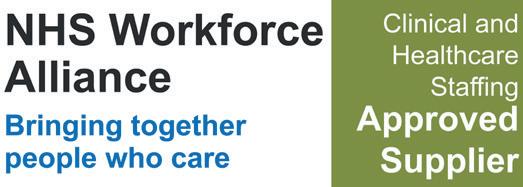

Enquiries
Call: 0208 863 7400
Head Office: 10 High Street, Wealdstone, Harrow HA3 7AA
Email: info@C4SS.co.uk
Est. 2007
F The framework lists transparent rates and costs for both PAYE and limited company temporary workers, including for fixed term appointments.

Non-NHS contracting authorities are able to specify what pre-employment checks are needed: for example, Baseline Personnel Security Standard (BPSS).


The framework offers the possibility to direct award to enable quick access to workers when needed.
Buyers are able to access a range of tools to aid in the selection process, including rate card, award support tool and region/skills matrix. The framework is also free to use for buyers, no membership is needed and framework fees are collected from suppliers.
Carbon Reduction Plan
Suppliers listed under lot 7 have agreed to comply with the Procurement Policy Note 06/21 : ‘Taking account of Carbon Reduction Plans in the procurement of major government contracts’. Suppliers listed under other lots may also have a carbon reduction plan, which can be found on the individual supplier’s details page.
A Carbon Reduction Plan (CRP) is intended to help customers understand the impact to the environment of a supplier’s operations. A CRP sets out an organisation’s emissions across the year, measured against a range of emissions sources and greenhouse gases. E
Frameworks 35
The framework lists transparent rates and costs for both PAYE and limited company temporary workers
Public sector recruitment services
Ethero Ltd and, via our wholly owned subsidiaries of Evergreen Resources 1991 Ltd and Enhance Financial Resources Ltd, is a licensed public sector recruitment service provider via the RM6277 Non-Clinical Staffing Framework

Ethero Ltd and, via our wholly owned subsidiaries of Evergreen Resources 1991 Ltd and Enhance Financial Resources Ltd, is an authorised public sector recruitment service provider via the RM6277 NonClinical Staffing Framework. With previous experience dating back more than ten years, we have been supplying staff to public and third sector organisations for over ten years. We are now seeking to develop our ability to supply into public and third sector organisations and we are authorised to supply in two key sectors: Lot 1: Admin and Clerical and Lot 2 Estates, Facilities Management and ancillary staff. We have over forty skilled recruiters to call upon in three specific divisions which perfectly suit the above requirements:
Ethero Ltd
Ethero Ltd has fourteen years’ experience of supplying ancillary level temporary staff and administration staff at all levels.
Enhance Financial Resources
Enhance Financial Resources is a financial specialist recruiter providing key support candidates into a diverse range of financial roles.
Evergreen Resources 1991 Ltd
Evergreen Resources 1991 Ltd has been supplying candidates into estates

management, maintenance and facilities management positions for over thirty years. As a group of businesses, we utilise the most modern candidate attraction and management technologies to ensure we can identify and process the best applicants at speed for our clients. During the pandemic, Ethero provided key support to several NHS hospitals and also logistics support to organisations. We place ethics and good practice at the heart of our organisation, and we believe our customer care and attention to detail will make us a great supply partner to any and all public or third centre organisations that select us a supplier. Our core values, which you can see below, drive our everyday operations and we believe are what give our business real identity.
E – ethical
T – tenacious
H – helpful
E – entrepreneurial
R – responsible
O – organised
FURTHER INFORMATION
orobinson@ethero.co.uk
ethero.co.uk
enquiries@enhancefinancial.co.uk enhancefinancial.co.uk
enquiries@evergreen.org.uk evergreen.org.uk

Advertisement Feature 36 BUSINESS INFORMATION FOR LOCAL AND CENTRAL GOVERNMENT | www.governmentbusiness.co.uk
F Lots and suppliers
The framework lists 210 suppliers in seven lots. The lots are as follows: Lot 1 Admin & Clerical (65 Suppliers); Lot 2 Corporate Functions (111 suppliers); Lot 3 IT Professionals (89 suppliers); Lot 4 Legal (20 suppliers); Lot 5 Scientific, Technical and Clinical Coding (20 Suppliers); Lot 6 Estates, Facilities Management and Ancillary Staff (68 suppliers) and Lot 7 MSP: Master/ Neutral Vendor (14 suppliers).


Lot 1
Lot 1 covers job areas including administration and clerical; secretarial; finance, accounts and audit; HR; information and communication technology; health informatics; library services; medical secretaries; procurement and supplies; project management; public relations; communications; customer services; and PALS. Job titles under this lot include administrator, clerk, secretary, receptionist, business support manager, digital transcription clerks, post-room assistant, post-room worker, telephonist, general administrator, admin assistant, admin clerk, clerical assistant, secretarial manager, filing clerk, personal assistant, call centre agent/handler, call handler, filer, co-ordinator, help desk operator.
Lot 2
Lot 2 includes finance, accounts and audit; HR; library services; procurement and supplies; project management; public relations; communications; customer services; PALS; senior business; administrative management; and media services. Professionals to be recruited under this lot include auditor, benefits assessment/benefits assessor, deputy group finance manager, and financial crime manager. Some of the lots do cover overlapping categories, so it is important to check the details of each lot carefully for the specific job role. There is a very helpful spreadsheet available, which sets out which job role is covered by which lot. E
Frameworks
37

F Lot 3
Lot 3 IT Professionals may include job roles such as infrastructure specialist/architect, security specialist, database developer, development manager, e-commerce consultant, telecoms manager, digital account manager, content manager, software engineer, architect (enterprise, solution, technical), technical author, functional consultant, technical consultant, business analyst, IT manager, programme manager, project manager, service delivery manager, problem manager, software licence manager, capacity manager, IT trainer, director of IT, and director of information management.
Lot 4
The Legal lot (Lot 4) is more limited and covers job roles including legal secretary, solicitor consultant and legal officer.
Lot 5
Lot 5 Scientific, Technical & Clinical Coding covers technical and environment & scientific services and may be useful for roles such as engineering assistant, engineering technician, waterways management, environmental health

officer, building maintenance engineer, building services engineer, surveyor, architect, structural engineer, senior engineering assistant.
Lot 6
Lot 6 is quite straightforward, it covers catering, drivers, estates and maintenance, facilities, hotel services, (hospitality), security, sterile services, and stores (and logistics). Staff included could be catering assistant, kitchen assistant, chef transport co-ordinator, driver, electrician, gardener, maintenance assistant, mechanic, estates co-ordinator, workshop technician, senior estates manager, technical services manager, maintenance supervisor, insulation work, safety equipment installer, carpenter, builder, health & safety officer, gas engineer.
Direct award
Direct award is recommended for hiring single or small groups of workers. Direct award should be used if it is clear from the contract documents that there is one supplier who can meet your needs as well as provide you with the best value for money. All requirements need to be covered by the framework specification. E
Frameworks Issue 30.4 | GOVERNMENT BUSINESS MAGAZINE 39
The Legal lot (Lot 4) is more limited and covers job roles including legal secretary, solicitor consultant and legal officer
We provide recruitment solutions for permanent, temporary & contract staffing throughout the UK. Delivering exceptional service based on our Company Values Trust Honesty Respect & Integrity .


We provide a range of services from Training to an extensive Outplacement Service alongside our Temporary and Permanent staffing solutions. info@r1rt.co.uk

Our mission is to be your chosen recruitment and training partner by improving our clients’ businesses and the lives of our candidates – we achieve this by matching the right candidates with the best available opportunities.
Representing businesses of all sizes and industries, from local SMEs to large blue-chip organisations. These partnerships have given us experience and an understanding of how critical a clients’ team is to business growth and success. Providing tailored solutions, giving you the confidence, that the right recruitment processes are in place to ensure successful outcomes.


01924 261636

Website Email Facebook Twitter Instagram LinkedIn
F The lot descriptions, Rate Card and Award Support Tool should be used to identify suitable suppliers. The Award Support Tool can help buyers to match the type of staff needed with the suppliers offering them. Suppliers can then be ranked according to their offers and value for money. CCS should be emailed for a copy of the tool.
In order to direct award, buyers need to identify suitable suppliers by using the tool, rank the suppliers by using the direct award criteria and then award a contract by using the simplified Short Order Form.
Further competition
There is also the option for further competition, which should be used if you want to make adjustments to the specification or terms. Using further competition may also achieve better
value for money. It is the recommended route when arranging a project through output-based delivery. It is not recommended for single or small groups of workers. Suppliers may choose not to take part in competitions for smaller requirements.
In order to run a further competition, buyers need to identify which suppliers can meet their needs and then invite all capable suppliers to bid. Further competition documents should then be sent to all capable suppliers, ensuring there is enough time for suppliers to return their tenders. New award criteria cannot be introduced, but changes can be made to the original award criteria.

Returned tenders can then be evaluated against the reward criteria. Evaluation plans and weightings can be adjusted within the range limits to reflect individual circumstances and requirements.

Once this process has been completed, the supplier with the highest score, who can provide the best value for money should be awarded.
If this supplier is unable to meet your needs, then the next highest scoring supplier should be awarded. E
Frameworks 41
The Award Support Tool can help buyers to match the type of staff needed with the suppliers offering them
with



We adopt a project planning approach to candidate placement, meticulously matching the right talent to your needs without the sales pitch.

Leveraging the expertise of former professionals from various sectors including healthcare, sports, finance, and law, Our team, comprised of dedicated workforce specialists, is both driven by empathy and fuelled by an earnest commitment to enhance healthcare services. Frontline Health Professionals stands unmatched in tackling the challenges of healthcare staffing.
Together, we'll help shape your workforce strategy to meet the demands of today and anticipate those of tomorrow. We're dedicated to placing the right people in the right roles promptly and securely.

Your HR & Corporate Functions Recruitment Partner Having been awarded the RM6277 framework, Annapurna engages with quality candidates for your corporate functions. With over 15 years professional services expertise across HR, Operations and Executive roles, we are here to help. www.annapurna recruitment.com +44 (0)20 3031 2468 Specialists in: Recruitment Strategy Project Delivery Increasing Efficiency Building Teams ‘Best Professional Services Agency’ at the Recruiter Awards
Gimmick
No Sales
Dependable Talent Acquisition
064 1920 office@frontlinehealthprofessionals.com 42 BUSINESS INFORMATION FOR LOCAL AND CENTRAL GOVERNMENT | www.governmentbusiness.co.uk
Call 0208
F Award Support Tool

The Award Support Tool can be used to direct award to a supplier without running a competition as it runs a price competition based on the criteria input. When running a further competition, the tool can also be used to help decide which suppliers to invite to bid.
Rate cards
There are two versions of the rate card available for customers: one is for NHS customers (it includes the NHS England price caps) and the other is for the rest of the public sector.
Customers can enter the worker pay rate and the rate card will calculate the full charge for whichever supplier is selected. It will also display all costs for hiring a temporary worker using the agreement.
The rate cards can also provide information on costs for hiring a fixed term worker and costs for transfer fees where applicable.



It is possible to award to multiple suppliers. In this case, the scope of each awarded contract should be clear and individual suppliers need to know that they do not have exclusivity.
Call off extension
There are no limitations on the length of a call off contract or extensions that you can use, and these should be in line with your local policy best practices. If you think you may need to extend a contract, it is recommended to make this known at the outset.


Documentation
Contracting Authorities should complete an order form in which they should state all the requirements needed from the supplier and the candidate including any training and the level of disclosure. The order form can also be used to award holistic/managed models and agree rates and SLAs applicable to order for an agreed period of time. Suppliers are also expected to return an Assignment Checklist to confirm all of the relevant candidate details preplacement. This framework from CCS allows public sector organisations to recruit across virtually any role, taking away much of the work that is required to recruit new staff.
Pin point your perfect match! Call Us: 01823 335 674 Over 50 years recruitment expertise www.job-seekers.co.uk
L
FURTHER INFORMATION Frameworks
The framework is available here.

Carbon reduction in procurement
A carbon reduction plan (CRP) is intended to help customers understand the impact on the environment of a supplier’s operations. A CRP sets out an organisation’s emissions across the year, measured against a range of emissions sources and greenhouse gases. The UK government has a target to reduce carbon consumption to net zero by 2050. This means, of course, that the public sector needs to be carbon neutral, and this involves procurement.
CRPs must: state a commitment to achieving Net Zero by 2050 in the UK; set out the environmental management measures in effect, that will apply when the bidder is performing the contract; outline the bidder’s “baseline emissions footprint”; be approved by a director (or equivalent); and be published on the bidder’s website.
The Carbon Reduction Plans written by suppliers include a commitment to achieving Net Zero and a declaration of the company’s baseline emissions footprint. This is a record of the greenhouse gases that were produced in the past, before the introduction of any strategies to reduce emissions. This serves as a reference point against which emissions reduction can be measured.
Baseline emissions include recorded emissions for Scopes 1, 2 and 3. Areas that may be covered by this and counted in the emissions include: electricity, heating, travel, printing, buildings, and waste. Some plans are more detailed than others, which may help buyers make a decision.
Each plan sets out steps that the organisation is taking to reduce their carbon emissions. Some of the actions listed might include moves to electrify the company fleet, when it is time to renew and encouraging staff to use greener methods of travel to get to work. This could include a cycle to work scheme. Video and virtual meetings may be introduced to avoid unnecessary travel, as well as more working from home.
Waste management could be included with an investigation into different waste streams and the introduction of a policy to reduce waste and improve recycling.
Some companies have committed to being paperless, by using more digital systems. Others have focussed on educating staff to reduce energy usage in the office, and particularly when working from home. This could include turning off appliances and lights when not in use. Staff are also encouraged to reduce water usage. Companies may also introduce a net zero champion to the business. Use of 100 per cent renewable energy is included by larger companies who are able to produce their own energy on site. Other companies are committing to sourcing energy from a renewable energy tariff. More energy efficient equipment is being introduced such as LED lighting and laptops instead of desktop computers. Carbon offsetting is another popular introduction.

Other measures include a commitment to using refurbished office equipment where possible.
It is hoped that the introduction of CRPs will help buyers make an informed choice in procurement. It is also hoped that seeing others’ CRPs will encourage more suppliers to create their own. L
Reduction
You might have noticed that some suppliers on Crown Commercial Service frameworks now have a carbon reduction plan. But what is it and how does it work?
Carbon
Issue 30.4 | GOVERNMENT BUSINESS MAGAZINE 45
Pictorial Meadows Turf
The adaptive and resilient range providing high visual, ecological and robust planting and landscaping solutions
The adaptive and resilient range providing high visual, ecological and robust planting


Transform your projects with instant perennial meadows using 100% flowers, with an average 30 species per mix and formulated to 150 plants per metre square. Available in nine unique varieties, each nurtured and grown in a nursery setting, which allows a higher percentage of germination than seed-sown meadows.
Transform your project with instant meadows using annual or perennial, 100% flower seed or turf mixes. Our meadows services team has experience of working on Olympic Stadiums, SuDs, new housing developments and everything in between. We can support with any element of consultation and design, meadow installation and maintenance, bespoke planting, training and CPD.


Call to find out more: 0114 267 7635 www.pictorialmeadows.co.uk
Get in touch today: 0114 267 7635 www.pictorialmeadows.co.uk


46 BUSINESS INFORMATION FOR LOCAL AND CENTRAL GOVERNMENT | www.governmentbusiness.co.uk MISSION STATEMENT Tel : +44(0)
28 2766 7049
Patchwork Quilt Super Pollinator
Woodland Fringe
Parks & Public Spaces
Highways & Verges
Urban Landscapes
Summer grounds care
Summer is here and that means more people are using our green spaces, how can we make sure that they are at their best for all those visiting?
Our parks, forests, fields and other green spaces provide great free days out for all ages, so it’s important they are in the best possible condition for those that use them. There are several areas to take care of. Proper summer grounds care is important to ensure the beauty, functionality and longevity of the local green spaces so that people can enjoy them. It is important to understand your outside spaces and what kind of care they might need, depending on their size, what they are used for and the kind of plants that grown there.
Grass
Overgrown grass is a quick way to turn people away from your green space, but it is also the easiest task to handle. We know that grass grows more quickly in the summer, so make sure grass cutting is scheduled regularly to keep it in check

Watering
It is likely that we will have more water shortages and hosepipe bans this year and in future years, so it is important to use water wisely. Grass doesn’t need regular watering, it always grows back. Try to plant resilient shrubs and plants that don’t need much water. You could consider watering methods such as drip irrigation. Mulch also helps to retain moisture and moderates soil temperature, as well as reduces weed growth.
Pruning
Shrubbery, hedges and trees also grow more quickly in the summer, so it is important that these are maintained to keep paths clear and ensure
that areas are safe and paths are accessible. Make sure to remove any diseased or dead parts of plants to encourage growth and restoration. Pruning also makes areas look nicer and more inviting!
Weeds
Weeds are also going to grow more quickly and unfortunately, they need taking care of as well to ensure the place looks tidy and to stop more weeds from growing and harming the plants that you actually want.
Pest control
Some insects can cause significant damage to your plants. It is good to encourage beneficial insects and birds which can help to control the pests in a natural way. For the beneficial insects and birds, provide shelter and food sources, such as flowering plants for insects and birdbaths or birdhouses for birds.
You can also consider using natural pest repellents or organic pesticides to protect plants. Harsh chemicals that can harm the environment and other wildlife should be avoided.
Litter
More visitors means more litter and you need to make sure you have the facilities to provide for this. Make sure there are enough bins and the bins that are there are emptied regularly. Put up signs encouraging people to take their waste home with them and advertising the penalties for littering to discourage it. L
Grounds care Issue 30.4 | GOVERNMENT BUSINESS MAGAZINE 47
Japanese Knotweed Agency launches capital punishment for UK’s No.1 invasive weed

Japanese knotweed is the UK’s No.1 invasive weed, estimated to affect 1.2M properties in 2023. The presence of knotweed on a residential property can reduce its value significantly and take several years to recover after a professional knotweed plan is in place. In all cases, mortgage lenders will refuse to lend on properties until a professional treatment plan is in place
Capital punishment for japanese knotweed
Glyphosate is the most heavily applied among pesticides in the world, and thus human exposure to this substance continues to increase. Glyphosate is the No.1 chemical used in the UK to treat Japanese knotweed, and has been identified by the World Health Organization’s International Agency for Research on Cancer (IARC) to be carcinogenic. It is being sprayed around thousands of gardens every week to combat knotweed, and is especially dangerous to children and animals. Glyphosate has been used for over 70 years and is said to be the biggest threat today to world health.
53 Local Authorities in the UK have now either totally banned the chemical or banned it from use in playgrounds, schools, public areas and similar, with an outright UK ban on this chemical in December 2025.
Japanese Knotweed Agency are the first entity in the UK to introduce a thermo-electrical solution not to control knotweed as chemicals mainly do, but to eradicate the knotweed once and for all over several treatments. Delivering up to 5,000 volts directly to the stems and crowns with each application, the high voltage electricity travels throughout the weed including its extensive deep and wide root system, effectively boiling the weed inside out, destroying its cell structure and removing its ability to regrow. The weed dies and composts down and the dreaded knotweed should be history. This treatment plan comes with a five-year guarantee, and can be used in almost all settings, private and commercial, including rivers and canals. This technology has been used across Europe for decades and proven itself beyond doubt to be the most effective solution. Transport for London have tested it in the UK for two years and have reported outstanding results, and King Charles as well as Arsenal Football Club are a few names believed to have adopted this technology for use on their own infrastructure.
Japanese Knotweed Agency are currently the only entity offering this thermoelectrical chemical-free solution to rid the UK of Japanese Knotweed. L
www.japaneseknotweedagency.co.uk
FURTHER INFORMATION
48 BUSINESS INFORMATION FOR LOCAL AND CENTRAL GOVERNMENT | www.governmentbusiness.co.uk Advertisement Feature
Protecting people and the environment
The discovery of Hemlock, a poisonous plant, on an overgrown path near a primary school in Suffolk has brought the issue to public attention
It was reported that pupils of Bucklesham Primary School in Suffolk had to walk in the road to avoid the plant, which can be fatal if ingested.
Responsibility
However, children on the way to school and other members of the public cannot be expected to identify dangerous plants that they may come across when out and about on public pathways. That’s why it’s important to have a reliable and detailed invasive and dangerous plant management plan in place and the skilled
personnel to identify and remove dangerous species.
For some plants, such as Japanese Knotweed, councils have a legal responsibility to manage invasive species within their areas of jurisdiction and prevent them from causing harm to the environment, property, infrastructure and people.


Identification
It is essential that you are able to identify the types of plants that are in the areas that you manage, and you need skilled personnel to be E
Invasive Plants Sponsored by Issue 30.4 | GOVERNMENT BUSINESS MAGAZINE 49
F able to do this effectively. Skilled contractors are able to identify Japanese knotweed, giant hogweed, himalayan balsam and hemlock and let you know of the presence of any plants that are harmful to human health and/or native species and how to then deal with them, once these species have been identified.
Many providers will offer a free survey and identification report, so if a dangerous or invasive species is not found, it won’t cost you anything.
You can contract this work out, but training courses are also available for you to train your
own staff to have the skills to identify invasive species. This could be your regular parks and grounds team, so they are able to identify plants immediately whilst carrying out their day-to-day tasks. It will also be quicker and easier to respond to any reports from the public if you have trained members of staff in house. Invasive species like Japanese knotweed spread quickly and can be more difficult to remove the longer they are left untreated. This means the longer you leave it, the bigger the job, the bigger the damage and the bigger the cost.
It is important to be able to detect invasive species quickly, so you address the problem quickly, either through the use of contractors or specially trained staff in house as mentioned above. Once identified, steps can be taken to warn people of the dangers and remove the threat.
Protecting the public
An area where a species such as Japanese knotweed or hemlock has been identified should be fenced off and signposted, so the public are aware of the presence and potential threat of the plant. This can also help to stop the spread of the plant.

Removal
There are a couple of ways to eradicate invasive species, one being herbicide. Herbicide tends to be a cost-effective measure as well as producing results. It is important that the herbicide is applied correctly and sustainably to remove the threat

50
Invasive Plants
without harming other plant and wildlife species, as well as any humans who may be in the area. There is also the option of excavation –removing the plant entirely. This though is harder work and more expensive and should only be carried about by trained contractors.
Dangerous and invasive plants do present a big problem for local authorities, as there is a responsibility to remove them. However, the resources are there to be able to do this. The thing to remember is that action should be taken swiftly. L








Issue 30.4 | GOVERNMENT BUSINESS MAGAZINE 51
Herbicide tends to be a costeffective measure as well as producing results Two decades as the market leader offering fully insured waranties, matching clients needs, budgets and timescales. www.japaneseknotweedcontrol.com CERTIFIED Call to book your site survey 0161 850 1604 / 0203 137 6199 • 20 years of invasive weed management • National coverage • Bespoke insurance backed warranties • Ecologically sound treatment methods ERADICATE Japanese Knotweed Sponsored by Invasive Plants
A Single-source Trusted Provider of Property Damage Solutions…


Insured Perils
Flooding and Complex losses
Fire & Smoke
Accidental Damage
Peril Support Mechanisms
Quantifiable Gravimetric Testing
Mould Analysis and Nano-Technology


Water Sampling Analysis
Surveying
Root Cause Analysis
Roof Membrane Testing

Leak Detection Analysis



Consultancy
Ventilation

Adequacy Compliance
Expert Witness and SMART Advice
Net Zero and Retrofit Assessments

Claim Support Platform Training
Independent Auditing
Independent Complaint cases
IoT Sensor Technology Monitoring
CPD Accredited Training
Property MOT® Survey Training
Bespoke Training of Choice

To learn more: 0344 846 0955 www.cornerstone-ltd.co.uk www.propertymot.uk
Damp and mould in social housing
The Property Care Association discuss how to introduce a successful strategy to deal with dampness and mould in social housing
The last six months have seen a seismic shift in people’s perception of what is acceptable when it comes to dampness in our homes. There can be little doubt that the tragic story of Awaab Ishak and the subsequent inquest which cited mould as the primary catalyst to the toddler’s avoidable death, should not have happened and must not be allowed to happen again. The conditions that the Ishak family were living in are not common but unfortunately occur more often than they should. Thankfully we are now at a point where more people realise this isn’t
acceptable and that no one should be made ill due to the home they live in.
Media coverage of damp issues has gone up exponentially too. Whilst regrettably stories about damp and mould have been a constant across mainstream media, they have undoubtedly become more frequent since the coroner’s ruling on this case.
The introduction of Awaab’s law will also increase pressure on landlords as they have to investigate and fix damp and mould within certain timescales. The Housing Ombudsman E

Issue 30.4 | GOVERNMENT BUSINESS MAGAZINE 53
Damp and Mould
SR Surveyors is an independent property surveying company, specialising in damp and timber. Providing all types of building surveys including full diagnosis of all damp and timber related problems










54 BUSINESS INFORMATION FOR LOCAL AND CENTRAL GOVERNMENT | www.governmentbusiness.co.uk NORFOLK │ SUFFOLK CAMBS │ ESSEX │ HERTS LINCONSHIRE NOTTINGHAMSHIRE LONDON www.propotec.co.uk 01638 741 377 Over 50 years of experience 30 years guarantee after work has been done A S S O C O N www.srsurveyors.co.uk info@srsurveyors.co.uk | 07738 887 737 • Damp and Timber reports • Condensation/mould surveys • RICS homebuyers reports & Home condition reports • Speedy Carbide Testing • Borescope inspections & Cavity wall tie inspections • Thermal imaging surveys • Airtightness Testing Independentsurveyors company
F too has been given new powers to improve landlord performance.
A growing issue
As an industry which deals with the investigation and remediation of damp in our homes, PCA members report they have seen a significant increase in calls to homes affected by dampness this winter, with problems becoming more severe and frequent.


A number of factors are contributing to the rising trend, predominately linked with modern living, and the cost of fuel. In many regards, we were quite fortunate this year and with a very mild winter, but costs are still rising, and we can’t bank on an equally warm winter this year
Contributing factors
Other factors include high occupancy rates, which are often understated and inaccurate.
As well as efforts to reduce draughts and the amount of fuel and heat used in homes which too frequently are poorly designed with a lack of continuity of insulation increasing the risk of cold bridging or no consideration given for the building’s ability to discharge water resulting in an increase in moisture-related defects.
It would appear that if we are not mindful, problems associated with damp and mould will become an increasing trend.
Effective ventilation
It seems fair to say that there appears to be a range of approaches taken when dealing with damp and mould in social housing. Too often we see remediation focus on the symptom and not the cause of the issue. Simply removing the mould and believing you have fixed the problem, will not solve the issue long term. It is vital that the conditions which have allowed the damp and mould to manifest themselves are addressed.
This normally means giving consideration to the thermal performance of the building, heat input, the levels of moisture produced within the building and its ability to deal with it. Moisture production is inevitable and with rising fuels costs, additional heat input is not always a viable option. One of the key elements to addressing mould issues can be the installation of E
Damp &
Mould
55
With more homes than ever being affected by mould, we need to do more and do it better
F appropriate and efficient ventilation. In many situations this can be the most appropriate way to resolve atmospheric moisture and air pollution problems where tenants face the challenge of mould and condensation.

A focused approach to ventilation
But let’s be clear, ventilation is required for so much more than just preventing mould growth. It is required to control temperature, pollutants and provide us with the fresh air we need to breathe.
There’s a need for a focused approach to ventilation and air quality across the UK. This would have benefits for the health and wellbeing of many, whilst reducing energy bills and improving the life of decoration and building fabrics. Adopting simple strategies would make considerable in-roads towards tackling the growing blight of mould and condensation for millions.
Building regulations and guidance
However, despite the impact which good ventilation can have on a property’s moisture
levels, the current regulation and guidance setting out minimum requirements in homes is mixed, and usually ignored or misunderstood. There are concerns about the impact and interpretation of Approved Document F – the Building Regulation which sets the minimum standard for ventilation in homes. Although recent changes now sets a required standard of air exchange for existing buildings, as well as new builds, it does not get the attention it deserves. Unfortunately, this standard is rarely applied where buildings are being renovated or improved and its exacting requirements are all too often simply ignored.
A pragmatic approach to ‘adequacy’
In the case of Approved Document F, our focus is not really on promoting a change in its scope, instead a pragmatic rather than a prescriptive approach to the question of “adequacy”, coupled with more efforts to impose and police these mandatory requirements is needed.
Our view is that using a rigid and prescribed rate of air extraction which is based on
Damp & Mould 56 BUSINESS INFORMATION FOR LOCAL AND CENTRAL GOVERNMENT | www.governmentbusiness.co.uk
assumed rates of occupation and background airtightness, can be counterproductive. Instead allowing specialists to design and install ventilation systems which are responsive to the needs of the occupant and consider the real airtightness and thermal performance of the building, can only produce better outcomes, save energy and deliver a healthy indoor atmosphere.
Education, awareness and specialist knowledge
We would like to see more robust reporting structures, greater accountability for ventilation installers and consequences for landlords who fail to deliver buildings which are safe and dry. These aims can only come to pass if they are coupled with a culture of education and learning for all housing professionals. There’s a need for empowered and technically competent specialists who can deal with dampness, condensation and mould issues. Decisions and interventions should be based on science and understanding rather than assumption and prejudgements. Every housing
officer, landlord, surveyor and building professional should have the knowledge to at least understand the causes and implications of dampness when it is seen or reported.
The health and wellbeing of the occupant
With more homes than ever being affected by mould, we need to do more and do it better – making sure that the right outcomes are delivered quickly, efficiently, and work is done right, first time, every time.
Approved Document F rarely gets the attention it deserves and is not enforced to the same extent as other areas of the building regs. The consequences of failure to comply with Approved Document F are never going to be a dramatic as they are for failing to comply with Approved document B (fire safety) and Approved Document P (electrical safety), but failing to provide adequate ventilation should not be taken any less seriously – after all, we are considering the health of the occupants. L www.property-care.org

FURTHER INFORMATION Damp & Mould Issue 30.4 | GOVERNMENT BUSINESS MAGAZINE 57
New fire safety regulations came into effect in England this year, requiring residential buildings to update some of their fire safety equipment and procedures.
One key stipulation is the new procedures around checking fire doors, including routine checks and inspections of fire doors.

Fireco provides a comprehensive third-party accredited fire door inspection service, complete with digital reporting.
Our DorTrak software will provide:
Dynamic real-time information

Detailed, summary reporting to view multiple doors at once
Easy-to-read reports with images and floorplans
Digital record that contributes to your Golden Thread
Get 5% off your first fire door inspection by quoting “Advert” when booking.
Call 01273 320650 or email contact@fireco.uk
▶
Regulations to improve fire safety

The FIA looks into the introduction of the Building Safety Act 2022, and specifically Section 156 and what this means for Responsible Persons
The one constant thing in the fire safety community since the Grenfell Tower disaster, the subsequent inquiry, and reports into it, is change. The introduction of the Building Safety Act 2022, and specifically Section 156, has brought in phase three of the Home Office plan for improving fire safety in higher risk buildings. The Act will further amend the Regulatory Reform (Fire Safety) Order 2005, which was revised recently in phase two of the Home Office plan by the Fire Safety (England) Regulations 2022. The ultimate aim is to deliver fire safety improvements for all premises that fall under the Regulatory Reform (Fire Safety) Order 2005, and ensure that residents in a building which contains two or more sets of domestic premises, receive relevant fire safety
information for their building. While section 156 of the Building Safety Act 2022 does highlight residential buildings containing two or more sets of domestic premises, the changes affect all buildings and premises that are in the scope of the Regulatory Reform (Fire Safety) Order 2005. This will mean that responsible persons (RPs) will now have additional duties that they must comply with. In brief, the changes are: record their Fire Risk Assessment (FRA) in full; ensure that they do not appoint a person to assist them in making or reviewing a fire risk assessment unless the person is competent; record the identity of any person appointed by the RP to assist them; record their fire safety arrangements; take reasonable steps to ascertain whether there are any other RPs E
Fire Safety Issue 30.4 | GOVERNMENT BUSINESS MAGAZINE 59

F that share or have duties in respect of the premises; and inform the other RPs concerned of their name; an address in the United Kingdom at which they, or someone acting on their behalf, will accept notices and other documents; and the part of the premises for which they consider themselves to be an RP and keep a record of that information.
Prepare now
The majority of these requirements will come into effect from the 1st of October 2023. However, item 2 “ensuring a competent person is carrying out the risk assessment”, will not be implemented at this time, this will happen at a future date, so it is important to begin preparations and to think about the competency of the person carrying out your fire risk assessment. The FIA recommend the use of UKAS approved, third-party certified companies to carry out any fire safety work. Examples include the BAFE SP205 Scheme and the FRACS Scheme by Warringtonfire.
Legal duties
The amendment of the Regulatory Reform (Fire Safety) Order 2005 will place new legal duties

on responsible persons (RPs) to record their fire risk assessments in full. The amendment changes the previous requirement of having a written fire risk assessment only where there are five or more employees to include all premises, regardless of number of employees. This means no matter what size organisation you are, you will have to record the findings of your fire risk assessment. The amendment has also changed what must be recorded within the fire risk assessment, as the word “significant” E

Fire Safety 61
The majority of these requirements will come into effect from the 1st of October 2023





F has been removed from article 9 (7)(a) of The Regulatory Reform (Fire Safety) Order 2005. Consequently, it is no longer just the significant findings of the risk assessment but ALL findings of the risk assessment, including the measures which have been, or will be taken by the responsible person, as required by the Regulatory Reform (Fire Safety) Order 2005.
Information required
Furthermore, the amendment will require the responsible person to give residents of a building, which contains two or more sets of domestic premises, comprehensible and relevant information about the relevant fire
No matter what size organisation, you will have to record the findings of your fire risk assessment

safety matters of the building. These fire safety matters include: the risks to residents of the domestic premises identified by the risk assessment; the preventive and protective measures; the name of the responsible person and an address in the United Kingdom at which the responsible person, or someone acting on their behalf, will accept notices and other documents; the identity of any person appointed by the responsible person to assist them with making or reviewing an assessment; the identity of any persons nominated by the responsible person to assist with non-automatic fire-fighting equipment; any risks where two or more responsible persons share, or have duties in respect of, premises, which the responsible person has been informed of; and any other matters specified in regulations made by the relevant authority.

Risk assessment
While simply providing the residents with the risks identified within the fire risk assessment, residents may not fully understand the implication and magnitude of any risks that are identified. This might require further information to be provided to residents in order to provide reassurance to the residents on what the level of risk actually is and what the consequences might be. Along with this, and this might be considered most important, is the supply of information on the mitigation factors to be implemented, and a time scale for completion of any remedial works/actions that the risk assessment has identified requiring attention. E
Issue 30.4 | GOVERNMENT BUSINESS MAGAZINE 63
Anti-viral & Anti-microbial paint
Certified 91.5% Human Coronavirus reduction in 2 hrs
Certified 99.3% E-coli reduction in 4 hrs
Certified 99.9% other bacteria reduction in 24 hours
10x concentration of silver biocide compared to the nearest equivalent from other decorative paint brands
Solid, leach-proof biocidal nano-particles throughout the coating for long-lasting protection
Meets and exceeds requirements of Health Building
Note 00-10 Part B Walls and Ceilings
Class 1 Wet scrub resistant to ISO 11998 to extend redecoration cycles
Max opacity – 50% greater than other paint brands to save coats
Pure acrylic resin polyurethane smoothed and hardened to prevent microbial “harbours”
Dual-action paint that doesn’t compromise on finish quality!
Bacteria are living organisms with soft protective membranes which enable the living cores to thrive, multiply and colonise on surfaces outside of a body. Once inside us, their membranes protect them from our antibodies long enough to infect our lungs.
Although most Viruses rely on a living “host” to reproduce and survive, Coronaviruses, Influenza and other “envelope” viruses have a “shell” that protects their living cores enough to both survive outside of a body and shield them from our antibodies once inside us. Unless damaged, their spikes can penetrate.
Bacteria and Shell Viruses can lurk on surfaces waiting to be picked up by hand contact and breathed in when we bring our hands near our faces.
Fortunately, their membranes, spikes and shells are vulnerable to direct contact from surfaces of walls they contaminated if a wall has enhanced heat reflection created most effectively by solid silver particles. The effect is enhanced if the silver is encased in glass as nano-particles distributed through the paint film when mixed for
01524 944701
permanent protection. This is unaffected by the leaching processes which can diminish further the limited effect of silver nitrate and chlorine biocides.
Anti-Viral Certificate FoC after application via website. Although Vira-Protect kills viruses and bacteria, it does not reduce the need for good hygiene practices.
www.protectionpaints.com
sales@protectionpaints.com

*Unrivalled efficacy achievable in one coat (two coats may be required for vibrant colours and where a strong colour change is needed)
F Other Responsible Persons
The changes brought in by Section 156 will mean that there is also a requirement for responsible persons to identify, and share information with other responsible persons in the premises, to help facilitate a cohesive approach to fire safety throughout the entire building. If the building changes hands, or a new organisation becomes the responsible person, the outgoing responsible person must share fire safety information with incoming responsible persons when control of the building passes between them, thus enabling a continual record of fire safety information throughout a building’s lifetime (the Golden Thread).
Such fire safety information includes: records of risk assessments carried out; the identity of the risk assessor who made or reviewed the risk assessment; the name of any other person who is a responsible person in relation to the premises and an address in the United Kingdom; where the premises consist of or include a higher-risk building, the identity of any other person who is an accountable person in relation to the premises (where known);
and any fire safety information given under regulation 38 of the Building Regulations 2010.
Higher risk buildings
With regard to higher risk buildings which are at least 18 metres in height, or have at least 7 storeys and contain at least 2 residential units, the Responsible Person must take steps that are reasonably practical to identify any other Responsible Persons, and also coordinate and cooperate with each Accountable Person (as defined in Section 72 of the Building Safety Act 2022).
Once section 156 of the Building Safety Act 2022 comes into effect on the 1st of October 2023, a greater amount of information will need to be recorded and shared with others, including residents. With no word of when the competency requirements will come into effect, the advice to Responsible Persons is to start making plans to check the competency of anyone carrying out or reviewing a fire risk assessment for a building before the legislation requires it. L

www.fia.uk.com

FURTHER INFORMATION 65
A greater amount of information will need to be recorded and shared with others
for Workplace Health Prevention Engineering
workplace health and safety issues, Reactec lace wearable with expanded functionality.

Leaders in HAVS Prevention
Supports the Control of Vibration at Work Regulations 2005 and follows latest HSE guidance
1 2
3
Wrist mounted device that automates the tracking of tool usage and daily exposure points calculation.

Real-time calculation of exposure level or time remaining on tool.
Operator alerted when personal EAV and ELV exposure values are exceeded.
Validate your risk assessments
Easily control your workers’ exposure levels
Identify preventative control measures such as training or tool selection
Automated reporting of individual and company-wide exposure, online and by email.

Bluetooth feature identifies exposure risk in real-time.
Tool tags with determined vibration to comply with regulations (TEP). Plus unique sensed vibration to find hidden risks (SEP).
Reactec Analytics

Readily accessible reports and alerts are available online, auto-emailed, and are easily shared with all stakeholders
Risk level
Worker identity
Tool in use
24 hour time display
Informative back-lit display to see: Haptic sound and vibration alerts increase to highlight levels of risk
Granular detail on tasks and tool use
- worker activities
- tool utilisation and performance
Clear and pertinent information to prioritise efforts on the hierarchy of controls
Record and monitor the impact of control measures and interventions
Secure access to intuitive analytics, hosted on a robust and GDPR compliant, scaleable cloud platform
For more information about how R-Link can support your prevention engineering contact Reactec:
T: 0131 221 0920 sales@reactec.com www.reactec.com
66 BUSINESS INFORMATION FOR LOCAL AND CENTRAL GOVERNMENT | www.governmentbusiness.co.uk
TEP SEP
Over 100,000 UK workers have already benefitted from Reactec’s first HAV management watch
1 2
3 4 5
Raising awareness of the asbestos risks that remain today
Almost a quarter of a century ago, the importation, supply and use of all asbestos was banned in the UK. The ban, in 1999, was due to the risks to health following inhalation exposure to asbestos, however the deadly impact of past exposure continues today – asbestos is the single greatest cause of work-related deaths in the UK, responsible for 5,000 deaths a year. While the ban has ensured that many workers will be spared the exposure that previous generations suffered, due to the nature of their activities, certain occupations remain at risk today – one of these being workers involved in construction activities involving older properties.
Asbestos could be found in any building built, or refurbished, before the year 2000 and properties built in the fifties, sixties and seventies are highly likely to include asbestos. This means across the UK many tradespeople today will be in working in houses and buildings that contain asbestos.
The importance of communicating this risk was highlighted in a recent Work and Pensions
report – ‘The Health and Safety Executive’s approach to asbestos management’, which recommended sustained campaigning specifically targeting tradespeople.
Dangers
If asbestos fibres are inhaled, they can cause fatal and serious diseases such as mesothelioma, asbestosis, and asbestos-related lung cancer. Unlike many health risks in the workplace, these diseases will not affect you immediately, they often take a long time to develop, but once diagnosed, it is often too late to do anything.
Asbestos is dangerous when not maintained in a safe condition or if physically disturbed without the right measures in place to avoid fibres being released into the air. This is why tradespeople can be at significant risk, as their activities can often disturb materials containing asbestos during repairs and refurbishment, and unlike dust, you can’t see, smell, or feel asbestos fibres in the air or on your clothes. E

Asbestos Issue 30.4 | GOVERNMENT BUSINESS MAGAZINE 67
The Health and Safety Executive tells us about their ongoing asbestos campaign
F There is noticeable difference between homes and commercial properties regarding asbestos and the risks to tradespeople. The Control of Asbestos Regulations 2012 contains a duty to manage asbestos, which is directed at those who manage non-domestic premises, and includes protecting others who work in such premises, or use them in other ways – such as tradespeople, from the risks to ill health that exposure to asbestos causes.
However, in domestic properties, homeowners generally look to tradespeople to be the expert, and many will be unaware whether their property has asbestos or not – highlighting the importance of asbestos awareness to those working in this environment.
Aims
HSE’s mission is protecting people and places, its 10-year strategy includes reducing workrelated ill-health. Supporting this was our overarching objective to contribute to the reduction of the overall number of tradespeople from exposure to asbestos leading to a decrease in those becoming afflicted/dying from asbestos-related diseases.
To achieve this, we had to raise awareness of the issue, to inform and educate the target audience about the risks from asbestos. And we wanted to test which messages resonate with the audience, and the channel mix, to see which achieve the greatest impact on the behaviours of tradespeople following the recommendations of the Work and Pensions Committee.
Insight
HSE had run campaigns previously targeting tradespeople in the 2000s (Hidden Killer) and 2010s (Beware Asbestos), which supplied detailed insight into this audience, which includes electrical fitters, joiners, plumbers, painters, plasterers, and roofers.
To ensure this information was up to date, as well as working with our insight team, we arranged focus groups with representatives from across the UK. The views from those experiencing the risk in their day-to-day work life validated previous research and highlighted a key point, which had become more important in the eight years since our last campaign, many young workers did not see the risks of asbestos, considering it a problem of the past – one for the ‘old timers’.
Asbestos & You
Our challenge was to make the risks of asbestos relatable to in trades, especially younger workers, or those new to the industry, while highlighting the importance of this issue.

The gauntlet was thrown down to HSE’s design team, who came up with Asbestos & You – a campaign identity which hints at the personal relationship our audience can have with asbestos and how they must be aware of the dangers it poses.
Using brush and pen fonts to provide a personal feel, the creative uses a patterning effect based on asbestos. What makes the creative really stand out is the use of red as the main colour, commonly associated with danger and stop, red is also the colour construction disposal bags use to highlight that they contain asbestos.

Asbestos 68
There is noticeable difference between homes and commercial properties regarding asbestos and the risks to tradespeople
We recognised the challenges our audience faced, being out on jobs and the lack of time to sit down and research, therefore our communications had to be easy to read and understand, providing the information in a simple and concise way.
To achieve this, we created the Asbestos & You campaign site, a single webpage, which hosted our new ‘Quick guide for trades’ – an easy read reference document to help tradespeople deal with asbestos on every job, and signposted HSE’s asbestos essentials – more detailed task sheets, as well as links to further information.
We understood that not all workers and selfemployed tradespeople were plugged into HSE communication channels, which meant to take our messages to them we needed to use the channels they did use at a personal and professional level.
Our approach was to adopt a multichannel campaign, building on our owned communications (website, email and social media). This involved stakeholder engagement, involving industry groups, such as the Construction Leadership Council, and trade organisations including the Institute of Carpenters, The National Federation of Roofing Contractors, and the Contract Flooring Association, to disseminate our messages to their members.
Supporting this, we tapped into social media platforms used by our audience, targeting workers on Facebook, and LinkedIn. In addition, we worked in partnership with On The Tools –the UK’s largest and most engaged construction community with over 6.9 million followers. This resulted in two fantastic videos: a minidocumentary that brought to life the risks of
asbestos through the real story of a tradesperson who has sadly contracted mesothelioma due to asbestos exposure; and ‘A Day in the life of an asbestos removal expert’ – highlighting what to look for when out on the job.

Finally, we wanted to ensure that we got our messages out to tradespeople who may not be digitally active, to achieve this we worked with leading builders merchant, Jewson, ensuring our campaign materials were issued to more than 400 stores across the UK.
Asbestos & You launched Monday, 6 March, and will run at least until the end of March 2024, so it is early days in terms of evaluating the impact of the campaign. We have been able to measure key metrics to assess the performance of the various tactics we employed, which have delivered some impressive results. Already we have seen more than 100k page views online, which has driven over 36k downloads of the quick guide.
Campaigns like Asbestos & You are essential to HSE’s mission to reducing work-related ill health, and it is only by delivering concerted communications through a variety of channels that we deliver a real-world impact to protect workers from the dangers they face. The response from across industry, and from those on the frontline, has been overwhelmingly supportive, highlighting how collaboration with stakeholders is key to delivering a wide reach to a varied audience. Asbestos & You is still at the start of its journey, but we are confident it is on the right path to raise awareness in those trades at highest risk, and to protect workers today from the effects of asbestos exposure in the future. L
More information can be found here. FURTHER INFORMATION Asbestos Issue 30.4 | GOVERNMENT BUSINESS MAGAZINE 69
The next generation in access control that secures, controls and audits all access



The convenience of a mechanical key system plus the access permission and tracking capability of an electronic access control system come together with CyberLock. With a CyberLock system, it no longer matters where the lock is. Electronic access control is possible.




▶
Solutions Offered By Cyberlock



CyberKey: An electronically programmed key that overcomes the many limitations of a mechanical key. It can access a wide range of different locks, that can be individually time and date restricted. There is no limit on the quantity or design of CyberLocks the CyberKey can open. If lost – it can be disabled.
sales@sellox.co.uk
sellox.co.uk
+44 (0) 1273 741528


Locations covered: United Kingdom, Ireland, Switzerland, & Asia

Upgrading and maintaining public sector estate
Many U.K. public sector buildings are in a state of disrepair and must be upgraded. In June 2023, the government launched an inquiry following a National Audit Office report that found hundreds of schools needing major repairs after years of cutbacks and insufficient maintenance
workforce can deliver planned and reactive maintenance works, reducing labour costs. In addition, sensors and analytics can be installed in vacant or empty properties to monitor any vacant or partially occupied space remotely.
Managing energy performance
This comes during a significantly challenging period for public sector managers who are facing new funding cuts to public services, ongoing supply chain disruption and skills shortages, and increasingly stringent environmental legislation and standards, including the UK’s net zero carbon targets associated with the 2008 Climate Change Act. The Government Property Strategy, published in August 2022, set out the government’s aims to transform places and services, create a smaller, better and greener estate, and improve professional excellence and insight. It’s crucial to remember that the quality of the estate — by far the biggest, most diverse portfolio in the U.K. — has a direct impact on the quality of public services that citizens depend on. Public sector managers need facilities management service partners that can help them make their operations more efficient and support the path to net zero by providing a combination of traditional engineering and digitally enabled solutions.
Reducing operational costs

Low-cost, quick-to-implement technologies will help public sector managers streamline and manage spend effectively. Digital ondemand access to Integral’s engineering
According to the UK Green Building Council, 80 per cent of the buildings that will be occupied in 2050 have already been built. With the built environment contributing 40 per cent of total global carbon emissions and the lawrge proportion of ageing, deteriorating buildings in the public sector, the scale of the challenge is clear. The solution is data-enabled retrofitting and asset management to prioritise investments and maximise the benefits for the lowest possible cost – equipping existing buildings with new technology and systems for high energy efficiency and low ongoing maintenance costs. Retrofitting, as well as an essential means to decarbonise, can help transform the built environment into smart spaces that serve a variety of purposes and functions in the most efficient possible way. As a concept, retrofitting should be viewed beyond carbon. A broad lens is needed, one that enables a more holistic approach towards space use that centres around how humans interact with the built environment. Using digital solutions, analytics, and smart condition-based FM, Integral can help organisations lead the way, embedding sustainable practices that will improve asset performance, lifecycle, and efficiency, while reducing operational energy use.
72 BUSINESS INFORMATION FOR LOCAL AND CENTRAL GOVERNMENT | www.governmentbusiness.co.uk
FURTHER INFORMATION
Sales & Solutions sales@integral.co.uk www.integral.co.uk
Mark Evans, Director,
Advertisement Feature
Saving money on energy costs
Public buildings such as libraries, leisure centres and community centres are struggling with their energy costs. However, many of these provide a lifeline for those that are struggling with energy costs at home. How can these places save energy, be more energy efficient and stay open for those that need them?

We know that the cost-of-living and energy crises are hitting people hard and local authorities are doing what they can. Libraries, leisure centres and community centres are low-cost or free days out, but also they are often the location of foodbanks, or internet hubs which are providing essentials to families that need them.
Therefore it is essential that these places are able to stay open over the summer holidays when children are off school and need entertaining and are also likely to not be receiving free school meals. Of course they
also need to stay open into and throughout the winter, when the buildings will likely function as (official and unofficial) warm banks, as well as food banks.
Energy saving
With all this in mind, here are some top tips for energy saving in public buildings over the summer.
Of course there are many ways to save energy, bring down costs and save money. The most obvious is only using energy where you need it. E
Energy Issue 30.4 | GOVERNMENT BUSINESS MAGAZINE 73
The importance of cavity wall insulation
Oscar Onsite, the UK’s Leading Authority in Cavity Wall Insulation Surveying & Extraction, discuss the importance of correct processes and methodology for removing insulation
Oscar Onsite are the UK’s Leading Authority in Cavity Wall Insulation Surveying & Extraction, having trained hundreds of firms across the UK in correct processes and methodology of removing insulation, which is no easy task.
Oscar Onsite are a GQA Approved Training Academy and have written and launched the only formal NVQ Qualifications for the industry in Cavity Wall Insulation Inspection & Surveying and Cavity Wall Insulation Extraction & Clearance

With 17 million homes having Cavity Wall Insulation installed and with an estimated 5 million having been installed incorrectly or subsequently failed since install for a variety of reasons, and the majority of the 17 million installs needing to be replaced over the coming 10 years, it is extremely important that homeowners, landlords, local authorities, housing associations and all governing bodies are aware of the issues that can go wrong with cavity wall insulation and how it can cause extensive damage to property and can also lead to significant health issues for those living in a property with failed Cavity Wall Insulation (CWI).
Oscar Onsite, alongside their Royal Institute of Chartered Surveyors partner firms, have designed a bespoke Cavity Wall Insulation – Condition Inspection Survey to help identify the current condition of CWI and ascertain if remedial works
or an extraction need to be completed. The survey checks the entire outside of the property to ensure it is weathertight and waterproof and will report on fascia, soffits, guttering and downpipes; windows and seals, doors and seals, brickwork, pointing, damp proof course, and all other areas visible and identify if remedial works need to be completed, along with a number of invasive borescope checks to look inside the cavities using specialist camera equipment and report on the current condition of the cavities and insulation within. The surveys are carried out to a strict format and each is reviewed and commented on by a Chartered Surveyor.
Given the position of Oscar Onsite in the market place, these onsite surveys and reports are delivered at only £295 including VAT, a significantly reduced cost than most firms may charge for a survey that is not as detailed or as bespoke.
Oscar Onsite have member firms all across the UK who have successfully attained the required national Occupation Standards to carry out this work and are committed to providing an excellent service.
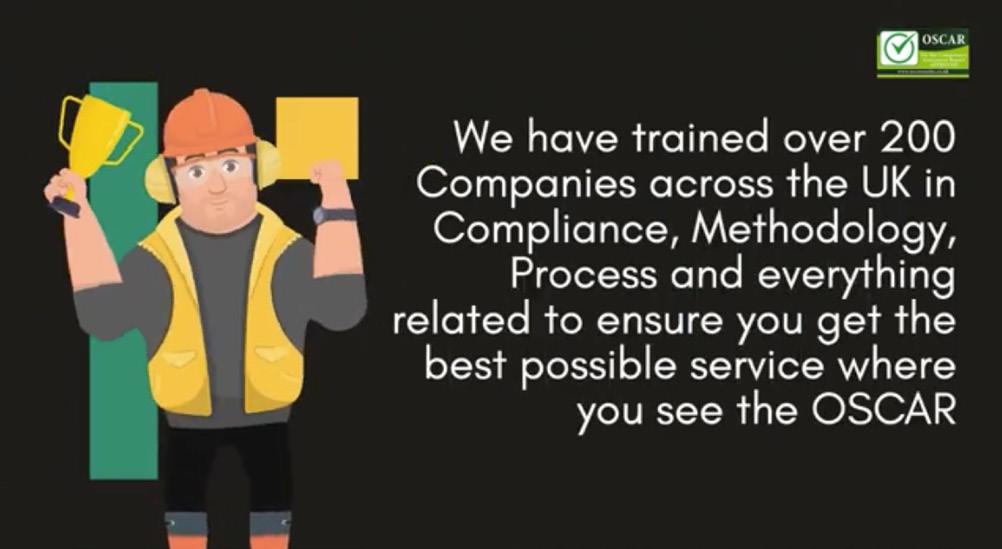
Visit Oscar Onsite here to learn more about our CWI Condition Inspection Surveys L
FURTHER INFORMATION
https://oscaronsite.co.uk
74 BUSINESS INFORMATION FOR LOCAL AND CENTRAL GOVERNMENT | www.governmentbusiness.co.uk
Advertisement Feature
F
Don’t turn the lights on in the daytime, when the room is light already. As well as this, you should invest in energy-efficient lighting, which may be an added cost at the beginning, but will bring down the costs in the long-term.
If you run a library or community centre that provides digital access, make sure the computers are turned off when not in use, especially overnight and over weekends when facilities are not open to the public.

Of course, heating shouldn’t be on in the summertime, make sure you know how to and are able to turn it off. You can even consider turning down or even turning off the heating in the swimming pool – most people probably won’t even notice the difference and may even be grateful for the cool temperature when it is hot out.

Don’t use energy in rooms you don’t need to. For example, you don’t need to leave the lights on in the store cupboard, or in a meeting room that is not in use. Also the toilets don’t need to be heated, no one will be in there very long. You could try putting motion-sensor lights in rooms like toilets and meeting rooms, so they only come on when people go in.
Energy tariffs
If possible, try to look for a cheaper energy tariff. It may take a bit of work, but the benefits of lower energy prices will be worth the time spent researching or haggling with energy providers.
Energy production
Of course, you can also start producing your own energy. Solar panels are a great place to start. These can easily be installed on the roof of your building or in the carpark, over parking spaces. Summer is the best time to install them, so you can make the most of them straightaway. In the end, they pay for themselves. Reducing energy costs is a great way to save money, which can then be spent and invested in other place to continue to provide much needed services for local residents. L
Energy 75
The UK’s Active Travel journey is not
as smooth as
it seems
Rebecca Morris, head of communications at RoadPeace, the national charity for road crash victims explains some of the dangers faced by walkers, wheelers and cyclists and how to address these
Active Travel has become a buzzphrase in recent years - widely used by local authorities, the government and the media alike. And rightly so. We must make urgent changes to respond to the challenges of climate change, air pollution and public health, as a result of inactivity.
We’re all being urged to leave our cars behind and opt for walking, wheeling or cycling instead.
Active Travel is considered such a priority, that in 2022, a National Active Travel Commissioner role was created by the Government, and a number of Walking and Cycling Commissioners have been appointed in major cities across the UK.
Research shows that Active Travel can decrease congestion, air and noise pollution, and is linked to health and economic benefits. We
can protect the environment, keep fit and save money – what’s not to love? Sadly, quite a lot.
In countries like the Netherlands, which have an abundance of off-road cycle tracks and footpaths, Active Travel has been embraced with open arms for many years.
But in the UK, where we often have little choice but to walk, wheel or cycle alongside multitonne vehicles on the road network, it can feel like an intimidating and threatening place to be.
And as we approach August - the height of the holiday season - and annual National Road Victim Month, even more of us are getting out, getting active and enjoying the warmer weather. At this time of year, the risks can feel even greater.
A right to be safe
In May, the Government announced that £200m will be invested into cycling and walking schemes, including 121 miles of new cycle track, 77 miles of new paths and greenways and initiatives to make streets safer around 130 schools.

RoadPeace, the national charity for road crash victims, welcomes these investments. But while this is an encouraging step, these changes do not go far enough, and will only benefit a small proportion of active travellers.
Everybody has the right to be safe when they use the roads, however they choose to travel, and should be entitled to get home safely to their families at the end of each day.
But disappointingly, many vulnerable road users do not feel safe. This fear and intimidation from road harm is a major barrier to choosing Active Travel.
It has long been said that every driver should be a cyclist for a day, to understand just how threatened cyclists can feel when sharing the road with cars, vans and lorries, who are often oblivious to their vulnerability.
Road Safety 76
Parents feel this vulnerability too, as they cling tightly to their children’s hands on narrow pavements, unable to hear their chatter due to the noise from traffic. Dog walkers keep their pets close to them. And horse riders are on their guard, hoping that vehicles pass them slow and wide. It can feel like a relief, if we do make it home safely, that we made it in one piece. That we survived.
But sadly, not everybody does make it home. In 2021, 128,209 people were reported killed or injured in road crashes in the UK. Of these reported deaths and injuries, 16,654 were pedestrians and 16,458 were cyclists.
A right to drive?
Many of the problems seem to stem from the sense of entitlement that can be felt all around us on the roads. We’re all busy. We’re all important. We’ve all got to be somewhere. Now.
The larger the vehicle, the greater the risk. And, quite often, the greater the sense of entitlement.
But whether we’re an HGV driver or a pedestrian, we have exactly the same right to use the roads.
Driving is a privilege. Not a right. And it seems that this point has been largely missed by many. Perhaps it has a lot to do with how safe we feel, cocooned in our vehicles which seem to cater to our every need – climate control, Bluetooth, cushioned seats, cup holders and the latest sound system. In there, it’s all about ‘us.’
But out there, on our roads, we are all equals, and we need to realise that it is our duty to behave in a way that keeps ourselves and others safe. At RoadPeace, we believe that those with the greater risk of causing harm have a greater responsibility to manage that risk.

Research has even shown that interventions designed to keep people safe can actually have the opposite effect. With an increased perception of safety, some people are more likely to take risks .
Human beings also possess a natural tendency to overestimate their likelihood of experiencing positive events and underestimate their likelihood of experiencing negative events.
Known by psychologists as Optimism Bias, we’re more likely to think ‘It won’t happen to me. E
Road Safety
Issue 30.4 | GOVERNMENT BUSINESS MAGAZINE 77
It has long been said that every driver should be a cyclist for a day
F I won’t be involved in a crash’ than ‘I’d better take great care today to ensure I keep myself safe.’
What’s stopping us?
And if all that wasn’t enough, the biggest problem we face is how society perceives road collisions. Even though the majority of crashes are preventable, we largely continue to describe collisions as ‘accidents.’ But exceeding the speed limit, drinking and driving or using mobile phone behind the wheel –some of the leading contributory factors in road crashes – are far from accidental.
Using the term accident is, as one RoadPeace member once described, “A description with an excuse embedded within it.” The phrase, “ It was just an accident” serves both as a claim of innocence and as an exoneration.
That is why RoadPeace is calling for the end of the language of denial in our longstanding campaign ‘Crash not Accident.’
Furthermore, road crime is not often treated as real crime. Far more people are killed annually on UK roads than through murder and terrorism combined, yet it is rarely taken as seriously by society, or by the judicial system.
With limited police presence and predictable speed camera enforcement, drivers have little fear of detection if they do offend.
And those that are prosecuted for motoring offences, scarcely receive a sentence that recognises the severity of their actions. So, is it any wonder that we see multiple people speeding, using handheld mobile

phones at the wheel or driving in other dangerous ways, every day on our roads?
If we compare the sentences received by dangerous drivers with those received by other offenders who have posed a risk to human life, there is a staggering disparity.
For example, this man was rightly jailed for five years after he was found to be carrying a loaded gun in his backpack on his way to work. The court recognised the huge risk he posed to public safety and this was reflected in his sentence.

Road Safety 78
Even though the majority of crashes are preventable, we largely continue to describe collisions as ‘accidents’
But in contrast, the man in this case, who arguably presented the same level of potential harm, if not more, because he actually used his lethal weapon – the two-tonne vehicle he was driving – avoided a jail sentence.
He drove at speeds of up to 130mph for 25 minutes, fleeing police and forcing his way through traffic, driving on the wrong side of the road and speeding through a red light. He intentionally and persistently put so many lives at risk, and on sentencing him the judge said it was a ‘miracle that nobody was hurt during the shocking pursuit.’ Yet, he was sentenced to just 10 months’ imprisonment, suspended for 21 months, with 240 hours unpaid work.
All this tells him and the other drivers reading the news report is: “It’s actually not so bad if you disregard the rules of the road. You might not get caught and even if you do, you won’t be properly punished. It’s probably worth taking the risk.”
Policing our own roads
Mike van Erp, known on social media as Cycling
Mikey, is a cyclist who uses a helmet camera to record footage of drivers behaving dangerously and flouting the rules of the road in London. He regularly reports the offences to the police and later uploads the footage to his YouTube channel
Mike said: “Cycling in London is mostly safe, but it often feels incredibly scary and dangerous. It certainly could be safer, which is why I do so much bad driving reporting.
“Some drivers have a sense of entitlement and are territorial about the roads, not wanting to share with pedestrians and cyclists. My use of cameras, and those of tens of thousands of others, is there to prevent this and to improve the standard of driving.
“Most of all, segregated cycle lanes increase safety and comfort for all road users, not just cyclists. Protected bike lanes have led to a drastic decline in fatalities.”
He added: “There’s very little traffic policing due to Government cuts, and the Government’s view is that road crime isn’t really a crime. Having third-party reporting is one way to turn the tide on that.
“Many drivers in London are now really worried about drivers and cyclists with cameras reporting them. Last year there were almost 15,000 prosecutions started by the Met Police based on third-party reports. It’s clearly something the public really wants.”
Active Travel – a slow starter
Active Travel sounds incredibly positive on paper and many of us are eager to embrace the obvious benefits it brings to the environment. But unless our roads and our road users become significantly safer overnight, we are still a long way off.


People need to be safe, but more importantly, they need to feel safe. And currently, many people don’t. We have no choice but to use the roads, if we want to leave our homes. But we shouldn’t be living in fear when we do.
Right now, many people feel frightened, unheard and uncared for on the roads. We need to feel reassured that road crime is under control, before we are urged to expose ourselves and our families to the dangers posed by Active Travel. And sadly, with the significant cuts to roads policing and the lack of priority road harm receives by the Government, that could take some time. L
FURTHER INFORMATION
RoadPeace provides information and support services to people bereaved or seriously injured in road crashes and engages in evidence-based policy and campaigning work to fight for justice for victims and reduce road danger.
To seek support, please call us on 0800 160 1069 or contact us via email at helpline@roadpeace.org Road Safety Issue 30.4 | GOVERNMENT BUSINESS MAGAZINE 79
Explore the future of security at International Security Expo 2023
The world’s premier government and end-user security event returns to Olympia London on 26-27 September, International Security Expo 2023, set to provide security professionals with all the tools they need to take on current challenges and stay ahead of the curve for the future threats that may arise

Martyn’s Law updates you won’t get anywhere else
Across the Conferences and Summit there will be essential updates for those looking to make sure they know how to comply with the Terrorism (Protection of Premises) Bill, aka Martyn’s Law, when it becomes law, including from those
who drafted the legislation, those who will be implementing and enforcing it, alongside those who have been campaigning for it.
Shaun Hipgrave, director Protect and Prepare for the Home Office, Office for Homeland Security, will discuss Martyn’s Law from a policy perspective and how it fits into the priorities for the Office for Homeland Security. This is a unique opportunity to understand the Government’s thinking behind the legislation that has been passed to Parliament.
NaCTSO (National Counter Terrorism Security Office) have been charged with ensuring Martyn’s Law is implemented once it hits the statute books, with preparations already underway to ensure they are ready. A senior NaCTSO official will talk about those preparations and how people can get real practical advice to ensure they are ready. Elsewhere, they will give insight into their future preparations; what they are looking at three to five years ahead.
Looking at the legislation from a different perspective, a panel discussion featuring Tobias Ellwood MP, chair of the Commons Defence Select Committee, Chris Medhurst-Cocksworth, head of Pool Re Solutions and a senior member of NaCTSO, will explore the practicalities behind Martyn’s Law from a parliamentary, implementation and insurance perspective.
Figen Murray OBE and Nick Aldworth will return with a panel delving into some of the areas within the draft legislation that may require amendment or clarifications, asking how the wider security community can help in the delivery of Martyn’s Law.
80 International Security Expo
NaCTSO (National Counter Terrorism Security Office) have been charged with ensuring Martyn’s Law is implemented once it hits the statute books
The latest, essential security insights International Security Expo has built a reputation for its world-leading content programme, and this year is set to be no different. An unmissable line-up of world renowned industry experts and high-level government speakers will ensure you stay ahead of the curve.

The Global Counter Terror & Serious and Organised Crime Summit, in partnership with
Counter Terror Business, will deliver high-level policy updates and strategic insights addressing the latest global terror and security trends and priorities. The International Security Conference will look at the practical implementation of new policies and how these should be applied within different areas, whilst the International Risk & Resilience Conference, in partnership with Resilience First, will give the latest thinking E
International Security Expo
Issue 30.4 | GOVERNMENT BUSINESS MAGAZINE 81
F and practical insights from individuals and organisations who live, eat and breathe risk and resilience.

The place to find innovation in security
For security buyers, specifiers and decisionmakers, the exhibition floor is the ideal place seek out the next generation of security solutions. More than 300 international exhibiting brands will spotlight their innovative products and solutions. Product categories represented range from Screening and Scanning; Perimeter Protection; Hostile Vehicle Mitigation; Intruder Detection and Monitoring; Drone and Counter UAV; Access Control and Biometrics; and CCTV and Surveillance, attendees are certain to find the solutions to their security challenges, as well as being inspired by a hotbed of product launches revealed at the event.
Delve into specialist zones and pavilions
Showcasing the exceptional levels of support received from UK Government, the Government Zone will feature the leading agencies and departments, providing a unique opportunity to interact and learn about future plans.
Participants include Joint Security and Resilience Centre (JSaRC), Counter Terror Policing, British

82
International Security Expo
Transport Police, National Counter Terrorism Security Office (NaCTSO), UK Defence & Security Exports (UKDSE), FCDO Services, Security Industry Authority (SIA), Dstl, and Defence and Security Accelerator (DASA).
The Perimeter Protection Zone, in association with LPCB, supported by PSSA and sponsored by Barker’s Fencing, will feature the latest products from fencing, barriers, bollards, video surveillance and intruder detection, with the popular LPCB Live Testing Lab returning to put LPCB accredited products through vigorous testing live at the event.
The Drone & Counter UAV Zone hosts worldleading suppliers of drone and counter UAV capabilities. Elsewhere, the Counter Threat Pavilion, in partnership with CBRN-UK, Counter-
Attendees will also benefit from the event’s co-location with the industry’s hottest cybersecurity event: International Cyber Expo
EO-UK and ADS, will showcase companies from within these key industry sectors alongside live demonstrations.

Co-located with International Cyber Expo – 1 pass, 2 shows
Attendees will also benefit from the event’s colocation with the industry’s hottest cybersecurity event: International Cyber Expo, offering attendees a 360° view of the industry, providing a comprehensive platform to identify products and services from all corners of the industry. L
FURTHER INFORMATION
For more information and to register to attend this year’s International Security Expo and International Cyber Expo for free, please visit: https://www.internationalsecurityexpo.com/ government-business

83
International Security Expo
Haydock Park Racecourse: a place that makes your heart race
From the thrill of watching your horse cross the Winning Post to the delight of indulging in its fantastic facilities, Haydock Park Racecourse guarantees a great day out. But just as importantly, we’re also well known as a venue that leads the field in hospitality and holding events that are every bit as memorable as our racedays

and you’ll discover a stage for conferencing and events that is second to none.
Leading the field from conferences and corporate days, to product launches and meetings, we can cater for any event in style, all thanks to our exceptional range of executive boxes and luxurious suites which can accommodate up to 500 delegates. Alternatively, you can host a truly unforgettable gala evening or dinner dance in one of our beautifully appointed banqueting suites. With panoramic views over the famous racecourse, your clients can raise a glass as the sun goes down and enjoy an outstanding evening’s entertainment.
For larger events, Haydock Park once again can’t help but impress. Our unique location in the heart of 127 acres of parkland means that we can not only offer 1,000 square metres of indoor exhibition space, but also over 13 acres of hard standing exhibition areas for major events for up to 20,000 people.
In today’s modern climate, the ability to bring your teams together remains essential. By combining our inspirational sporting legacy with state-of-the-art facilities, we can help you to create a hybrid meeting with colleagues from all over the world. We have the space and facilities to make the whole process straightforward, effortless
It’s vital to keep your colleagues fed and watered throughout your event and our fresh, healthy and delicious food which is thoughtfully and carefully prepared by our team of exceptional chefs is crucial. Ingredients are ethically sourced from local suppliers wherever possible. We tailor the food offerings to our clients’ requirements, so if you fancy having a BBQ menu for a team building day or a light ‘working’ lunch, we cater for all needs, styles, and occasions.
To begin creating your dream event with us please contact our team below. L
FURTHER INFORMATION
thejockeyclub.co.uk/haydock/venue-hire/ Haydockevents@thejockeyclub.co.uk 0151 522 2922

84 BUSINESS INFORMATION FOR LOCAL AND CENTRAL GOVERNMENT | www.governmentbusiness.co.uk
Advertisement Feature
Looking after guests at summer events
Summer is well and truly here, but there are still several weeks left if you want to plan any last-minute events
Summer is a great time to host events, people are in the mood to socialise and get out of the office and the weather offers to opportunity to get out into the fresh air. The evenings are also longer, meaning people are willing to stay out later after work for events.

Let’s look at the most important factor to consider when planning a summer event – the weather. This is the best reason to have an event in the summer. Hosting an event outside is a sure way for people to enjoy it – fresh air, sunshine, nice views all go down well. There are lots of event venues that can host outside; country homes, vineyards, rooftop bars, racecourses and more.
Rain
However, the weather can also be our biggest foe at this time of year. When you’re planning your event in advance, while hoping for the best, you can never know what the weather will be on the day. Alas, in the UK, even if you’re planning the day before, you can’t be sure. There are two things to watch out for. Number 1, obviously the rain. This is why it’s important to have a Plan B. If you are hosting outside, make sure you have an inside or at least under cover option, big enough to house all your guests comfortably.
When picking a venue, also consider the ground it will be held on. High footfall, on a wet day, in a grassy area is going to create mud and people won’t enjoy it.
Sun
The other potential problem is the sun. Being outside in the sun all day, is dangerous and can pose the risk of sun burn, heat exhaustion or sun stroke. So again, this is another reason to provide cover (shade) or an inside area for people to stay out of the sun and cool off. It would be great to have air conditioning as well and somewhere to sit down.
With the heat, it is also important to provide enough refreshments for your guests –especially water.
Transport
Think about how people will travel to your event. One aspect to consider here is avoiding the tube in rush hour, which can get extremely unpleasant, with people often falling ill from the heat. You should also try to avoid people having to walk a long way. Maybe you could consider providing buses from major transport hubs. Summer events can be great and people will often remember them for the venues that can host outside. However, it is also important to make sure your guests are well looked after in the event of any unwanted weather events, whether that be rain or extreme heat. These are easy things to prepare for and if you get it right, your guests are sure to have a great time. L
Conferences & Events 85
100% ELECTRIC ZERO EMISSIONS NO RESTRICTIONS

The Goupil G4 is ideally suited to improve access into low emission zones, cities and town centres. With 11 different body configurations there is a Goupil to suit a number of applications.


GOUPIL ELECTRIC LIGHT COMMERCIAL ROAD VEHICLES WWW.BRADSHAWEV.COM/GOUPIL-ROAD-VEHICLES ENQUIRIES@BRADSHAWEV.COM 01780 782 621
Registration now open for RWM Expo 2023
Tickets are now available for the 2023 RWM Expo, the UK’s premier event for professionals working in the recycling, resource, waste, and wider environmental services industry. Formerly known as RWM & Letsrecycle Live, the event provides a platform to connect with others, learn, and drive positive industry and environmental change via discourse on sustainable resource management. The exhibition takes place on 13-14 September 2023 at the NEC, Birmingham. You can secure your FREE ticket here
Exhibition Zones
The exhibition is split into four distinct areas to provide a seamless and easyto-navigate visitor experience:
1. The Collections & Transport Zone Get ready to explore the latest solutions for sustainable refuse collection, waste
transportation, fleet management, street cleaning, route optimisation, and more at the expo’s dedicated area for those working in efficient urban cleanliness and sustainable waste management. Past & present exhibitors include: Volvo Trucks, Storm Environmental, Romaquip, Forvia Hella, Webaspx, Bartec Municipal E

RWM Expo 2023
Issue 30.4 | GOVERNMENT BUSINESS MAGAZINE 87
Multifunction - for all year round
Egholm at the ESS Expo 2023
Stand LR64
One machine - 18 functions
Thanks to its many attachments, the City Ranger 2260 can handle multiple tasks. Be it sweeping, winter chores, mowing or other tasks: Attachments can be changed entirely without the need for tools by turning the handle connecting the attachments to the front and rear. This allows for quick switches between different jobs and purposes - and it also saves time and ensures easy operation.



Its compact design and articulated steering make the City Ranger 2260 easy to get around even in difficult and tight conditions. At the same time, the excellent visibility as well as the ergonomic and intuitive operation guarantee simple functioning which is crucial for the efficiency of the machine and the safety of the operator.



For more information on the Egholm utility machines go to www.egholm.co.uk or visit us at the ESS Expo in NEC Birmingham the 13th-14th September, stand LR64.


Meet
www.egholm.co.uk
F Technologies, Integrated Skills, Carryway, Dolav, Totalkare, Vision Techniques, Excel Trucks, Whitespace Work Software, Kore, PacTec EPS Ltd, Ogden Safety Systems, Metrostor, LARAC, LAPV, Keenan Recycling Ltd.
2. Recycling Services
From software & AI solutions, to specialised services, to new strategies, policy updates, and the latest, greatest techniques and technologies - this dedicated section of the show focuses on the ever-evolving world of recycling - showcasing best practices in reusing and repurposing our natural resources.
Past & present exhibitors include: Smart Solutions, Valpak, TATA Steel, The Environment
Exchange, CIWM, Juno GP, Recycling Lives, N+P, Egger, Mist-Air Dust Suppression, Fairport Containers, SUEZ recycling and recovery UK, Wastepack, TOMRA, Sensoneo, Environmental Services Association, Grundon, The Recycling Association, WARD, Greyparrot, Recycleye. E

RWM Expo 2023
89
The ever-evolving world of recycling - showcasing best practices in reusing and repurposing our natural resources
T A L K I N G A B O U T U S
As an independent business with over 30 years of experience, Tusker is leading the way in the design and manufacture of complete recycling, fabrication, and building engineering solutions throughout the UK and Ireland. With an in-house design facility, Tusker specialises in managing end-to-end projects from design to build




▶ e a m o n n h @ t u s k e r n i . c o . u k E N G
O L U T
+ 4 4 ( 0 ) 7 5 8 5 2 9 4 9 9 4
I N E E R I N G S
I O N S T H A T L E A D T H E W A Y
H a r r o g a t e , N o r t h Y o r k s h i r e H G 1
F 3. Machinery & Equipment
Prepare to be impressed. This section showcases the cutting-edge machinery designed to process, handle, extract, and transform waste material - from shredders, balers, compactors, material handlers, wheeled loaders, sorting equipment and much more.
Past & present exhibitors include: Bollegraaf Recycling Services, Xtralis, Portakabin, Nihot, Sword Engineering, Terex Recycling Systems, REMA TIP TOP,


The outdoor section of the show is the place to see apparatus working in its intended environment (or simply a place to relax and enjoy food & drink in the Paignton sunshine!)
Pellenc ST, CK International, Machinex, Ulster Shredders, Coveya, Deltax Limited, Blazequel, Rotospiral, Orthos Engineering, Fagus-GreCon, TANA, SiteZone Safety.
4.Outside
From spectacular displays of industry-leading machinery, to live demonstrations of wasteprocessing equipment, refuse collection vehicles or street sweepers - the outdoor section of the show is the place to see apparatus working in its intended environment (or simply a place to relax and enjoy food & drink in the Paignton sunshine!). View live material processing, trucks in action, or some mouthwatering street food, ice-cold refreshments, live music, and exciting outdoor activities. E
RWM Expo 2023
Issue 30.4 | GOVERNMENT BUSINESS MAGAZINE 91

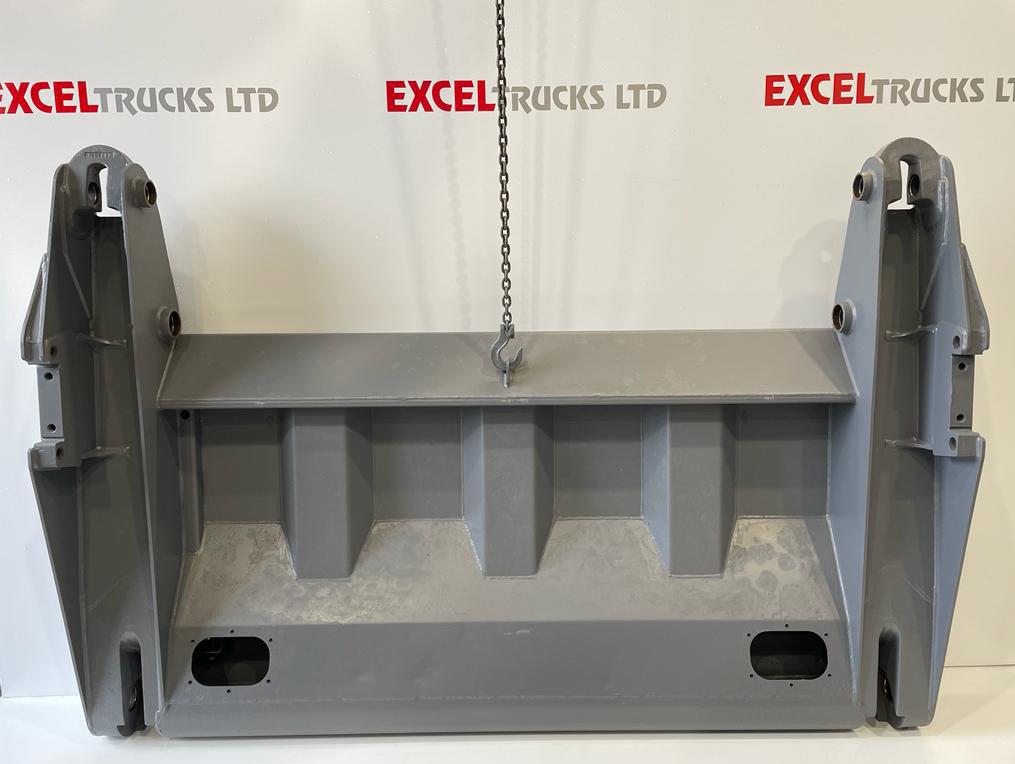

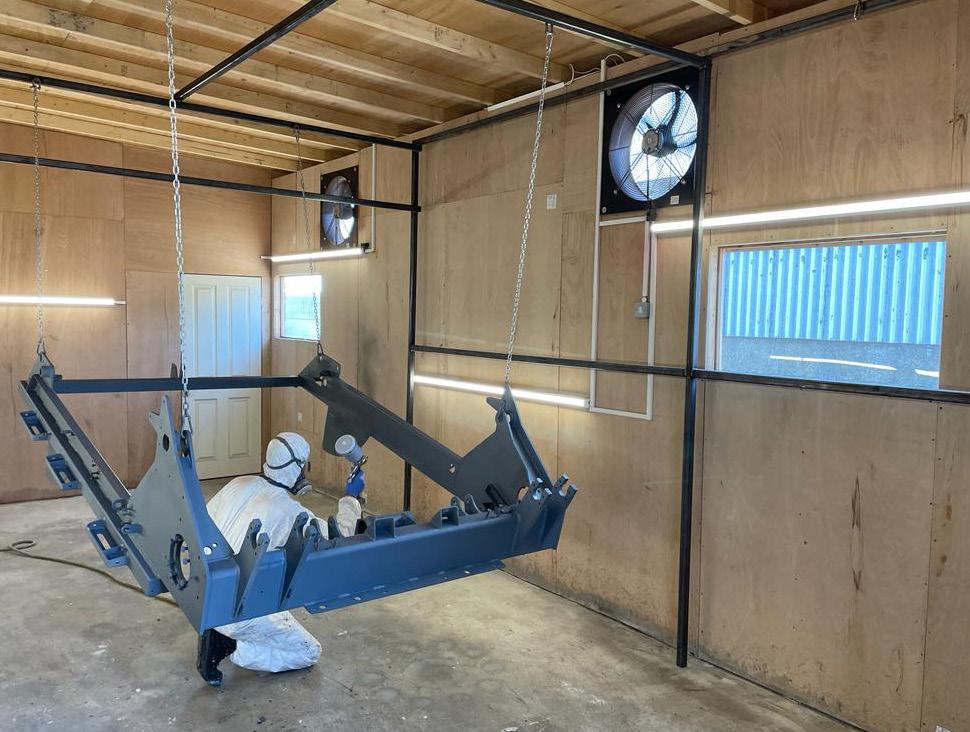
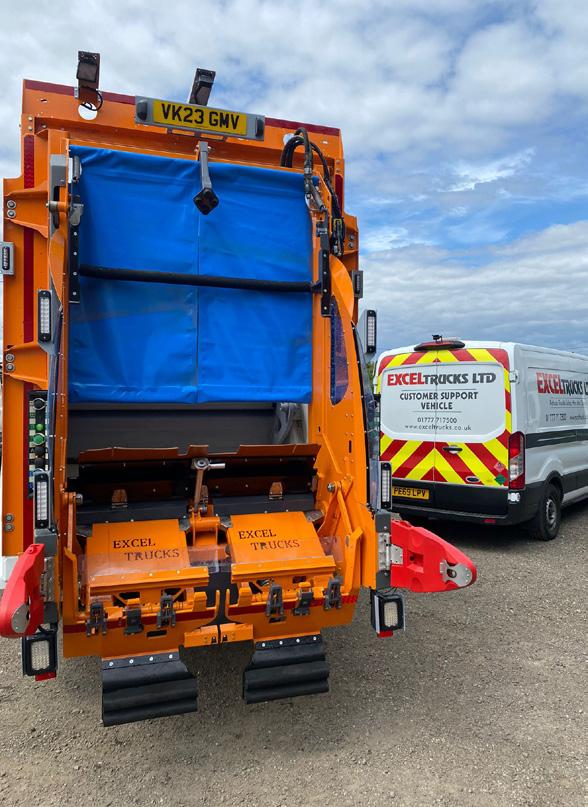

RCV Hire RCV Sales RCV Parts RCV Fabrication RCV Repairs & Maintenance Call us Hire 07904 687147 Parts & Enquiries 01777 717500 Email us hire@exceltrucks.co.uk parts@ exceltrucks.co.uk info@ exceltrucks.co.uk www.exceltrucks.co.uk
F Past & present exhibitors include: JCB, Finning CAT, Doyle Machinery, Blue Group, Dennis Eagle, Komptech, Aebi Schmidt, Bucher Municipal, RVS, Boweld Meiller, Fireward, Boughton Engineering, MachTech, Air Spectrum, Egholm, Addex, Neutron Equipment, Dustquip, Electra Commercial Vehicles, Addex Group, Inmalo, Kaizen Recycling, Go Plant Fleet Services.
ESS Expo 2023
This year will see RWM become part of the Environmental Services & Solutions Expo, forming the UK’s largest event dedicated to the environmental services industries, which attracts an audience of 12,000+ professionals. This conglomerate of events stems from a series of environmental B2B shows uniting under one roof at the NEC, giving rise to the ESS Expo. This massive expo now forms the ‘umbrella’ event for the following renowned exhibitions: (Resource & Waste Management Expo),


(Energy, Fuels & Decarbonisation Expo), FWM (Flood & Water Management Expo) and CLR (Contamination & Land Remediation Expo).
RWM takes place in halls 17, 18, and 19, in addition to a re-vamped 10,000m2 of outdoor
RWM Expo 2023 93























94 BUSINESS INFORMATION FOR LOCAL AND CENTRAL GOVERNMENT | www.governmentbusiness.co.uk www.alisonhandling.com 01772 687 940 THE UK’S LARGEST INDEPENDENT STOCKIST OF NEW, REUSABLE AND RECYCLABLE PLASTIC BOXES, TRAYS, PALLETS AND PALLET BOXES STAY AHEAD Andrea House | Freckleton Road | Kirkham | Lancashire | PR4 3RB enquiries@alisonhandling.com Refuse Systems De l i ve ri n g a n d i n s t alli n g for Local Auth orities an d Housing Associations Get in touch for our consultative support and best practice advice at enquiries@contenur com
F demonstration areas. The event is set to address a broad range of environmental issues, including resource management, net-zero targets, waste collection & transport, circular economy practices, sustainability, and much more.
What’s On?
The event will see more than 300 industry leaders speak in seminars, meetings and discussions as well as on-site material processing and live vehicle showcases. The full programme of events, speakers, workshops, talks and demonstrations will be released over the next few weeks. Also featured will be an on-site pub, street food market, live music, and a host of special guest appearances.
Visitors will able to hear from experts and key industry figures in the conference theatres, do business with over 600 worldclass suppliers , see the latest innovative equipment and vehicles in the demonstration
Visitors will able to hear from experts and key industry figures in the conference theatres, do business with over 600 world-class suppliers, see the latest innovative equipment and vehicles in the demonstration areas, and make powerful new connections


areas, and make powerful new connections at dozens of exclusive networking events designed to bring the industry together and spark meaningful change.
Key highlights for 2023 include headline speaker sessions from climate campaigners, environmental experts and numerous top-tier E
RWM Expo 2023 Issue 30.4 | GOVERNMENT BUSINESS MAGAZINE 95
Hand Placed Concrete Bagwork MSE Soil Filled Bagwork
Biodegradable bags and liners enabling the hand placement of concrete in and around watercourses.
Cost Effective Simple to Use Strong & Versatile Watercourse Protection







The real savings are not in material costs, but in the time saved in having a ready-toinstall product, and not having to dewater the watercourse to place the bagwork.
For more information...
T 01629 541066
E sales@soluform.co.uk
www.soluform.co.uk

UK leader in sustainable clothing
SoluForm MSE Bagwork is supplied pre-filled with a high quality sand rich topsoil, supplied in a form that is ready to use and assemble on site once it arrives.
Simple to Use Strong & Versatile Promotes Vegetation
It aims to establish and promote vegetation growth on, and inside the bagwork, giving the bagwork structure an improved appearance.



Textile re-use
Textile re use helps save the environment by reducing waste at landfills and offers people across the world with affordable apparel. Textiles make up about 3% of household waste, and more than 1 million tonnes of textiles are sent to landfill each year, according to estimates.

Textile collection
We provide a professional and efficient service through collaborating with local authorities, government agencies, and private businesses. Collected textiles are meticulously sorted, then graded for further re use and supplied, depending on quality, to end users. We strive for the highest quality reusable products and apparel that can be reused rather than disposed of in landfills since we focus on re use.
+44 116 326 3262

Home collection

Refuse, reduce, re‑use, recycle!!! We may arrange one time or recurring collections, and our service is swift, attentive, and polite. This service is offered to idividual members of public, who have no time to go to recycle centre or simply want to find a better use for things they have. We can help!


96 BUSINESS INFORMATION FOR LOCAL AND CENTRAL GOVERNMENT | www.governmentbusiness.co.uk
carb o n lartuenbrac o n neutral
of what we collect is getting re‑used
Click here to view our website 90%
Home Collection Service
Free
F thought-leaders in recycling, resource and waste management. Blue Planet II Executive Producer James Honeyborne, the Financial Times’ Moral Money Editor, Simon Mundy; and award-winning environmental campaigner Tristram Stuart . The show will also feature an exclusive Fleet Managers’ Forum, the yearly Women in Sustainability Breakfast Meeting, the Zero Waste Recognition Scheme, and the 35 Under 35 Awards, which celebrates and recognises the industry’s rising stars and future trailblazers.
Register Free Now
RWM is the ultimate platform to engage in critical discussions and explore groundbreaking green technologies, acting as an international springboard for innovative waste and resource solutions that address the world’s environmental challenges. As the United Kingdom’s top meeting place for waste and recycling activities, in addition to land, air, energy and water services through the co-located shows, it is unmissable for anyone working with or selling into Europe. E


RWM Expo 2023 97
In 2022, over 9,000 professionals gathered to see industry innovation and hear updates from 200+ expert speakers
RUGGED MOBILE Systems are specialist providers of robust mobile computing platforms suitable for challenging environments found in Waste Management, Street Cleansing and Winter Gritting carried out by, or on behalf of, Local Authorities. These robust computing platforms are ideal for running applications for control, management and data capture activities that reach directly to the front line – to the operatives and vehicles they use. RUGGED MOBILE Systems help you select the right mobile computing platforms for these crucial











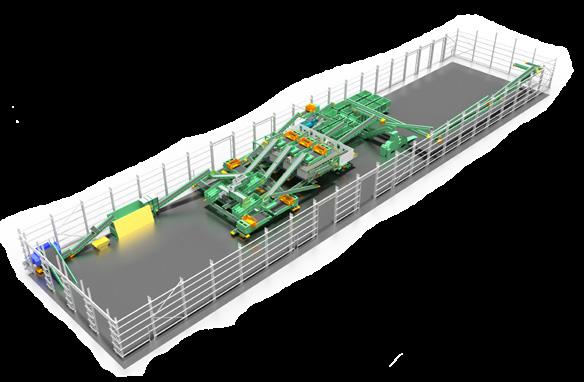




98 BUSINESS INFORMATION FOR LOCAL AND CENTRAL GOVERNMENT | www.governmentbusiness.co.uk Choose Turmec, Choose excellence, Choose sustainability
www.turmec.com
info@turmec.com
INGRESS PROTECTION RATINGS SUNLIGHT READABLE DISPLAYS MIL-STD-810G CERTIFICATIONS DROP RESISTANCE ROBUST COMPUTING HARDWARE THAT WORKS WHEREVER YOU DO
provide powerful, highly configurable, well-supported
Windows and Android platforms, hosting a range of rugged features including: Visit us on Stand R-J143 at RWM 2023 SPECIALISTS IN RUGGED COMPUTING HARDWARE & IN-VEHICLE PCS ATEX APPROVED EQUIPMENT INSTALLATION SUPPORT & DEMONSTRATION KIT FOR TRIAL COMPUTING PLATFORMS FOR AI, VIDEO ANALYTICS, AUTONOMOUS VEHICLES & MACHINE CONTROL
activities.
We
PCs running
F In 2022, over 9,000 professionals gathered to see industry innovation and hear updates from 200+ expert speakers. The event spans three exhibition halls and a large outdoor area for equipment, machinery, and vehicle demonstrations.

Organised in partnership with leading organisations including the Chartered Institutes of Wastes Management, Environmental Services Association and letsrecycle.com, get ready to connect with the biggest players and access need-to-know insights; all in one place over two action-packed days at the NEC, Birmingham.

The full programme of networking events, speaker sessions, workshops, talks, and live demonstrations will be released in the coming weeks. To be the first to hear announcements, register for your FREE ticket now, at the website below.
One FREE ticket gains you access to all events. L



FURTHER INFORMATION
Date: 13-14 September 2023.
Venue: NEC, Birmingham
Halls: 17, 18, 19 & 10,000m2 outside area
Opening Times: 09.30 - 16.30
https://hubs.la/Q01TtmzX0



RWM Expo 2023
Issue 30.4 | GOVERNMENT BUSINESS MAGAZINE 99 • 12 month free technical support • On site installation and training available • Manage Permits • View and Print Customer History • Ticket Design • Report Designer • Integrate with Sage and many other systems
and track your skip hire bookings with... For more information please call 01785 472472 or email sales@midsoft.com SkipTrak www.midsoft.co.uk/skip SkipTrak skip hire software manages bookings and tracks skips at the click of a mouse. SkipTrak has now developed into the leading skip hire software system sold in over 5 countries and over 600 sites in the UK alone. Using the graphics based scheduler bookings and skips can be managed effectively. SkipTrak can help reduce the number of lost skips as you’ll know exactly where every one of them are. and more on our website. deliveries and collections at the click of a mouse. RoadTrak is really easy to add new jobs, either in advance or retrospectively. • Schedule bookings and regular jobs • Easily raise repeat jobs and exchanges • Raise individual or batch invoices • Print delivery tickets in any format • Zoned or Area price bands • Customer unique pricing • Overdue skips management • Post Code lookup Features include: • 12 month free technical support • On site installation and training available • Manage Permits • View and Print Customer History • Ticket Design • Report Designer • Integrate with Sage and many other systems Manage and track your skip hire bookings with... For more information please call 01785 472472 or email sales@midsoft.com SkipTrak www.midsoft.co.uk/skip SkipTrak skip hire software manages bookings and tracks skips at the click of a mouse. SkipTrak has now developed into the leading skip hire software system sold in over 5 countries and over 600 sites in the UK alone. Using the graphics based scheduler bookings and skips can be managed effectively. SkipTrak can help reduce the number of lost skips as you’ll know exactly where every one of them are. Other software available include: deliveries and collections at the click of a mouse. RoadTrak is really easy to add new jobs, either in advance or retrospectively. • Schedule bookings and regular jobs • Easily raise repeat jobs and exchanges • Raise individual or batch invoices • Print delivery tickets in any format • Zoned or Area price bands • Customer unique pricing • Overdue skips management • Post Code lookup Features include: • One-Click Task Management • Flexible Invoicing & Ticketing • Integrated Maps • Wide Range of Integrations • Postcode Lookup • Add-On Hand-Held System
Manage
Improving recycling centres and improving recycling rates
Greater Manchester has improved its recycling rates to over 50 per cent by making improvements at household waste recycling centres
Recent figures have revealed that Greater Manchester is one of best performing cityregions in the country with household recycling rates rising to over 50 per cent. The national average in England is 44 per cent. For 2021/22, the landfill diversion rate is 98.4 per cent, meaning that only 1.6 per cent of waste collected from 1 million households across the nine boroughs of Greater Manchester was sent to landfill.
The majority of waste that cannot be recycled is burned to generate electricity.
Greater Manchester has attributed the improved recycling rates to improved recycling facilities across the 20 household waste recycling centres operated by SUEZ recycling and recovery UK.

Some of the improvements include new containers for mattresses, carpets, and hard plastics as well as containers where household items can be donated for reuse.
Renew shops
Three of the recycling centres also now have
shops where people can buy pre-used items that otherwise would have gone to waste. The Renew shops can be found at the recycling centres at Boysnope Wharf in Irlam, Arkwright Street in Oldham and Woodhouse Lane in Trafford.
The money generated at the shops is fed into Greater Manchester Mayor’s Charity (£100,000pa) and the Recycle for Greater Manchester Community Fund. The fund makes £220,000 available for community groups, charities and schools for projects which help prevent, reuse, or recycle household waste.
The recycling centres are open every day from 8am to 8pm (during British Summer Time), meaning they are easily accessible for local residents.
Street sweepings
Local authorities are now also able to recycle street sweepings. At a new SUEZ plant in Ashton-under-Lyne, Tameside, 90 per of the grit, soil, stones, leaves, twigs, and other debris swept from the roads is cleaned, separated, and recycled through a specialist,
Waste Management 100 BUSINESS INFORMATION FOR LOCAL AND CENTRAL GOVERNMENT | www.governmentbusiness.co.uk
hi-tech mechanical sorting process. Any organic matter is extracted and transferred to other processing facilities to be turned into compost and sand and aggregates that can then be used by the construction industry.
More of the recycling is also being done locally in local recycling outlets, reducing the reliance on overseas markets. All the paper and card that is being collected in wheelie bins and at the recycling centre is taken to a paper mill in Trafford, where it is recycled into more paper and card.

David Taylor, executive director of waste and resources at GMCA said, “SUEZ has made many improvements to the way household waste recycling centres are run since they were awarded the Greater Manchester waste and resources contracts in 2019, and I’m pleased to see that residents have embraced the changes and are recycling more and more.”
“We are giving residents new opportunities to recycle, which has benefitted our recycling rates but also has wider benefits for the cityregion. Just one example is our new process to recycle mattresses from the recycling centres. Mattresses can now be broken down into 19 different component parts that can be used again, and this new process has helped to create over 25 new jobs in the city region.”
Dan Carolan, SUEZ contract director for Greater Manchester said: “We’re pleased to see that the improvements we’ve made at recycling centres have helped to increase the recycling rate in Greater Manchester. We’re always looking at ways to improve our processes and make it as easy as possible for people to recycle.
“Collectively we should all try to consume less, which in turn reduces the amount of stuff we have to create waste from. The next best thing is to donate unwanted items for reuse and to buy used goods, to give them a second life. Once waste has been created, we recycle as much of it as possible, which helps conserve resources, reduce greenhouse gas emissions, and promote a circular economy which benefits everyone.”
The simple changes made in Manchester show that change is possible. It is hoped other local authorities and waste management providers around the country can make similar changes and therefore similar improvements in recycling rates and reduction in the waste being sent to landfill. L

Waste Management
101
We are giving residents new opportunities to recycle, which has benefitted our recycling rates but also has wider benefits for the cityregion

DATA DESTRUCTION TELECOMS DECOMMISSIONING & DISPOSAL Specialists in asset recovery and the disposal of electronic, IT and Telecommunications equipment. SECURE IT, ELECTRONIC, AND TELECOMS ASSET DISPOSAL ASSET MANAGEMENT 01942 811483 info@plexstar.co.uk www.plexstar.co.uk IT ASSET DISPOSAL WEEE RECYCLING For over 30 years, we have been the accredited recycling partner to our customers who span a variety of sectors in Education, Finance, Military, IT, Rail, Retail, Utilities and Telecommunications.
Encouraging people to recycle their electronics
Old electronics present a huge problem to those in charge of managing waste. It is important that this waste is disposed of effectively and as sustainably as possible. However this can only be done if those disposing of the waste are willing and able to do so

According to the Health and Safety Executive, an estimated 2 million tonnes of WEEE items are discarded by householders and companies in the UK every year.
Generally, WEEE refers to most products that have a plug or battery, electrical or electronic goods that are being thrown away. It is one of the fastest growing waste streams, with many products facing high turnover as technology improves every year and new technology is released.
Recycling these products is important to save natural resources, reduce carbon emissions and reduce mining for primary materials.
In order for these products to be disposed of sustainably, people need to be encouraged to do so.
A nationwide TV advertising campaign was launched early this year by Material Focus, a not-for-profit organisation funded by the WEEE compliance fee.
EThe Recycle Your Electricals campaign featuring a pink cat and a catchy tune aims to reduce the 155,000 tonnes of small electricals that are discarded every year.

It is hoped that the campaign will raise awareness of waste that people don’t see as electrical such as toys and toothbrushes. The advert points out that anything with a plug, battery or cable can be recycled and also shows what things can be recycled into.
Scott Butler, executive director at Material Focus said: “We are throwing away some of the most precious materials on the planet when unwanted electricals get binned. And this has to stop, now.
“We want everyone to know that they should never bin and should always recycle their electricals. Love or loathe him, HypnoCat is broadcasting on UK radio and TV screens with a mission to stop people in their tracks and to compel them to start recycling. He is bright pink, proud, loud and mesmerising. My kids and even Wally the dog have already been seduced by HypnoCat. For me he is the purrfect ambassador for our campaign. I challenge you to watch him and not end up reciting the whole thing for days after.” L
Waste Management (WEEE)
Issue 30.4 | GOVERNMENT BUSINESS MAGAZINE 103
Can technology bring improvements to social care?
Cllr Martin Tett, health and social care spokesperson for the County Councils Network reveals some of the findings from a recent report investigating the potential of technology to support those with social care needs
It goes without saying that the adult social care sector faces many challenges – ageing demographics, workforce pressures, and financial strains are just three of the most visible issues for local authorities. But what has perhaps gone under the radar is that a solution is right on our fingertips – technology. Over the last few years there has been a substantial shift in the number of
technology-based solutions that have come to market, and whilst they are not a silver bullet to solve all the issues within social care they can help to bring efficiency, ease the burden on staff and ensure targeted care for those who need it.
In this climate, ‘ Adopting the right technology to transform social care’ sets a precedent for implementing technological advancements within social care services and

Social Care 104
provides an informative guide for how to create lasting, positive change at a community level. The report was launched in partnership by the County Councils Network (CCN) and Tunstall Healthcare, and was released amidst the government’s ongoing focus on driving greater adoption of technology to achieve widespread digitisation across social care. This report launch follows on from CCN and Tunstall’s 2021 report; ‘Employing Assistive Technology in Adult Social Care’ which set out the multitude of ways in which advances in digital technology is on the brink of delivering a potentially transformative impact on the adult social care system. In this report, CCN and Tunstall argue that the potential of technology to support those with social care needs is growing ‘exponentially’ each year, and the study aims to spur a greater push towards the use of digital technology across the sector. Alongside the transformation of services, it was found that
digital transformation can hugely benefit care users, from allowing more independence to widening understanding around condition management and reducing anxiety.


The progress so far
Since ‘Employing Assistive Technology in Adult Social Care’ was published, it is clear that progress is being made in many parts of the country. The prime objective for embedding technology-based services in social care continues to focus on supporting care users in accessing the right support services. However, there is also a growing understanding of how people-focussed outcomes need to be a key driver of how and where services are delivered. In short, technology needs to deliver tangible benefits for both local authorities and people. From a policy perspective, the most positive step forward in the past year has been the priority the government has placed on technology as a means of improving adult social care services. Their ‘People at the Heart of Care’ white paper highlights a number of areas that the government expects funding to be directed. This includes procuring more and better assistive technology to support services, improving the establishment and maintenance of digital records and data, upskilling the adult social care workforce in how to use technology, and bedding in wider digital infrastructure and cybersecurity within systems. E
Social Care
Issue 30.4 | GOVERNMENT BUSINESS MAGAZINE 105
It was found that digital transformation can hugely benefit care users
F Government commitments
‘Next Steps to Put People at the Heart of Care’ also highlights the importance of digital transformation in adult social care. This, together with the ‘What Good Looks Like’ framework and ‘digital skills’ framework will help to frame what future services look like. What is clear is that both the public and private sector understand what needs to be done, but it’s a question of delivery i.e. ‘the how’ so that transformational gains can be made, especially in an era of tight local authority budgets where a lot of social care funding is funnelled towards those in crisis. Investment in digital by local authorities will also help to standardise services and provide support when switching to using digital technologies, such as 24/7 monitoring centres to provide quick and instantaneous support. This in turn will contribute to the development of new skills and innovations that can be deployed where and when they are most needed. Driving innovation and improvement is another important factor. Technology is developing all the time and we must continue to review the outcomes we want to deliver, making sure that technology can support effective delivery. An element of this is around improving data access and producing better insights i.e. the more data we have about someone, collected in an ethical way, then the greater the chance of using algorithms and machine learning to improve decision making on a user-by-user basis. Advancements in this area have the
potential to lead to all round better services that benefit users whilst making authority services more efficient and effective. Imagine how outcomes could be improved if we can potentially predict what could happen before it does? Whilst we won’t get it right every time, the potential is huge.
Practical steps for local authorities
As the report illustrates, the possibility of transforming the whole social care system, both delivering better outcomes for individuals and reducing costs for the state, does exist. But to achieve this, local authorities need to carefully manage a wider array of bureaucracy and organisational challenges to understand what care users need in the context of new and emerging technology, and then deliver excellent services that are efficient and effective.
There are a number of practical steps detailed in ‘Adopting the right technology to transform adult social care’ that are recommended to local authorities to enable the embedding of technology into social care services. These are as follows.


Social Care 106
The first is that underestimating the time it takes to embed change can seriously impact how quickly new solutions can be integrated into care. Organisational and cultural change needs to be led from the top and embedded throughout local authorities, ICSs and health, housing and social care services. If all stakeholders collaborate and work to the same strategy, implementation is easier and more likely to be accepted.
Secondly, when tenders are released, they are often complicated and time consuming to complete. Understanding what good procurement processes look like from a market perspective can ensure that these are easier to complete. This includes understanding the outcomes that local authorities and care providers want to achieve and stating them clearly, making sure questions are specific and to the point, and providing enough time for suppliers to respond to the tender, particularly if it requires cultural and service transformation.
Finally, working in partnership with providers can support the effective delivery of technology and data-led practice. It’s

important to understand that there are multiple organisations and providers that are available to provide advice and collaborate with. Supplier experts can provide advice on the most relevant solutions and service delivery, run services, and implement new technological solutions.
In all, the report was launched at an important time, with the government postponing social care charging reforms until 2024, giving us valuable time to assess what is needed for whole-system reform, especially with a new administration on the horizon whatever the result of the general election. And with a clear commitment from this government on the merits of greater digitisation, if local authorities begin a step-change now to deploying a greater range of technology in social care then will have significant long-term benefits.
If CCN and Tunstall’s 2021 report set out the why in adopting technology, this new study sets out the how. I hope many in the sector enjoy its recommendations and roadmap. L
The report is available here.
If all stakeholders collaborate and work to the same strategy, implementation is easier and more likely to be accepted
FURTHER INFORMATION Social Care Issue 30.4 | GOVERNMENT BUSINESS MAGAZINE 107
Working with the health service

Michael Laing, director of integrated community services, County Durham Care Partnership explains the collaboration between the NHS and local authorities
The most moving celebrations of the Coronation weekend for me were those which took place in our supported housing. Our extra care schemes, residential and nursing homes and specialist accommodation are a valued part of their communities. Schools, volunteers and faith groups all made an extra effort to include the people we care for in our supported housing. NHS Community staff, social care teams and primary care colleagues were all invited to join in. Most of the care we give happens in someone’s home and is delivered by a team every day of the year not just on a special occasion such as the Coronation.
Relationships
The Coronation Service was full of messages about relationships, symbols and tradition. The long lasting of the success of the County Durham Care Partnership is built on the relationships between individuals at all levels developed over many years. The Chief Officers meet fortnightly. We talk informally about a range of work-related subjects but we also get to know and understand each other, share problems and find joint solutions. There is also some talk about favourite foods, holidays, dogs, horses and our families. This incidental chat is important. It shows that
Health & Wellbeing 108 BUSINESS INFORMATION FOR LOCAL AND CENTRAL GOVERNMENT | www.governmentbusiness.co.uk
we are human and have interests beyond the formal work situation. It helps when we are facing pandemics, storms, floods and demand pressures to enhance and sustain our joint working. More importantly it helps us care for each other as unique individuals. Many Coronation guests wore medals and the neck chains of the orders of chivalry. I’m
told special permission is needed to wear the decorations of other nations. This may come from the time when the Earl of Leicester presumed to wear “foreign” symbols of office in front of Queen Elizabeth I. Her characteristic remark for all of the Court to hear was “My dogs wear my collars”. We are not quite so fussy in our Partnership. We give out our lanyard and badge pretty freely. We encourage people to wear it as an outward sign of being part of the Partnership. I always feel quietly proud when I see them being worn especially by people who are not members of the Partnership.
Durham Cathedral stands high above the River Wear and dominates the surrounding City especially when seen from the East Coast Mainline. It was illuminated red, white and blue for the Coronation. It began as a monastery in 995. One of the roles of the monks was to care for the sick. They were organised into groups of monasteries called provinces or congregations – similar to ICBs. Monasteries had infirmaries, dispensaries and almshouses – not unlike acute hospitals. They also had parishes and “cells” outside of the Abbey caring for people in villages and towns – just like primary and community services. The monk’s health and care system is part of our tradition and perhaps our future.
Finance
Integrated care systems need more than relationships, symbols and traditions to be successful. They need structures, administration and money. In County Durham we are working with our ICB in the North East and North Cumbria to co-produce a Joint Committee. We have been operating as a Joint Executive for many years and have structures which work well, reach shared decisions and make the most of the skills of our workforce and get best value from every penny. The Joint Committee is the natural development for the County Durham Care Partnership – but it is “new territory” in terms of governance. We have some Government guidance from late 2022 but we are working E


Health & Wellbeing
Issue 30.4 | GOVERNMENT BUSINESS MAGAZINE 109
Integrated care systems need more than relationships, symbols and traditions to be successful
F through the details together drawing on the expertise of the ICB’s head of governance.
Goals
Our ambition is to co-produce a Joint Committee which has “everyone and everything” related to health and care in scope. We know that this will be achieved over time. This means the NHS, primary care, Public Health, Adult Care, Children and Young Peoples Services, the voluntary and independent sector and Community Services. There is also an important role for housing and economic development. We want to jointly exercise our decision making capacity to commission services to meet needs, innovate, sustain and improve outcomes and support each other when we are under pressure. Above all we want to make it easier for our people to experience and deliver health and care services.

Trust
“Put not your trust in money but put your money in trust” said Oliver Wendell Holmes. Money and trust go together in the County Durham Care Partnership. How we spend and account for our money is key to all of our relationships. We can demonstrate that trust in our Better Care Fund, in the way we decide together how to invest money from the Discharge Fund and how we commission. We respect the different financial regimes of our partner organisations. However some of the important lessons from the Covid pandemic and austerity are about sharing our money to get better outcomes and supporting partners with financial troubles.
“While money can’t buy you happiness it certainly lets you choose your own form of misery” according to Groucho Marx. Agreeing the governance arrangements and culture for
110
Health & Wellbeing
our money is essential in the development of the Joint Committee. We work on “open book” principles now and we want to keep them in the future. If we don’t get the governance and culture of the money right we will be at risk of choosing our own form of misery.
Children & young people
We often concentrate on adults when we integrate services. In County Durham, children and young people’s services are “front and
centre” of our Partnership. We have appointed to some joint posts recently to lead our integration of children and young and turn our ambitions into operational changes and improved outcomes. The Association of Directors of Children’s Services (ADCS) President this year is John Pearce from Durham County Council. In his first speech as President he called for a Better Care Fund for children and young people and greater integration between health and care.
Joint posts across health and care have worked really well in County Durham. We have a Joint Head of Integrated Commissioning who is also our Director of Place. I am in a joint post between the Council and the Trust. We have joint posts in mental health and learning disabilities. Our aim is to have more joint posts in the future and more secondments between partners as recommended by the Hewitt and Messenger Reviews.


It seemed odd going to the North East and North Cumbria ICB “Winter De-brief” in bright spring sunshine. Our ICB is doing some great work in bringing us together and promoting good practice as well as listening to feedback from the “frontline”. They have put me in touch with North Cumbria who are doing some outstanding work on integration and our visit is already planned.
Going to visit customers in their homes with “frontline staff” is a great privilege. I’m often greeted with the line “Hello, where do you belong?” Which is a County Durham way of asking where I live. It emphasises the strong sense of “belonging” to a place felt by our customers and workforce. We will do well to remember that sense of place and belonging as we develop our Joint Committee. L
Issue 30.4 | GOVERNMENT BUSINESS MAGAZINE 111
Some of the important lessons from the Covid pandemic and austerity are about sharing our money to get better outcomes
Health & Wellbeing
Social enterprise calls on councils to join fight back against period poverty

A multi-award-winning social enterprise is calling on more local authorities in the UK to join the fight against period poverty following successes in its native Scotland
Musselburgh-based Hey Girls works nationwide to fight back against period poverty, donating a box of period products to community organisations like foodbanks and women’s refuges for every one purchased through its partnership schemes.
Partners range from construction industry giants to electronics manufacturers – as well as more than 80 local authorities who benefit from its reduced pricing for the public sector.
Nowhere is that more evident than Scotland, where local authorities are required by law to provide free period products under the Period Product (Free Provisions) Act, regardless of personal circumstance.
Georgie Nicholson, contracts and partnerships manager at Hey Girls, said she would like to see more local authorities in other UK countries implement similar schemes – regardless of whether they are required by law.
She said: “One in 10 people in the UK are affected by period poverty – and there will be no local authority areas in the country immune from it.
“We are seeing fantastic results in Scotland, although there remain hundreds of thousands of people who cannot afford something as basic as period products.
“And this comes during a cost-of-living crisis which is showing no signs of slowing down
Health & Wellbeing 112 BUSINESS INFORMATION FOR LOCAL AND CENTRAL GOVERNMENT | www.governmentbusiness.co.uk
– with our community partners seeing an ever-increasing demand for their services.
“It is something no one should stand by and accept.”
Creating empowered councils Hey Girls’ work with local authorities has seen its products made available in town halls and civic centres, while home delivery packs containing both disposable and reusable products have been made available to those in more rural locations.
The Hey Girls team handles the whole process for rural communities, from packing to dispatch.
Free period pickup locations can be found nationwide through the PickupMyPeriod app, available on both Apple and Android devices. Local authorities to have seen the benefits of partnering with Hey Girls include Fife Council, Denbighshire County Council and Essex County Council.
Brian Borland, community participation and development officer at South Lanarkshire Council, who have partnered with Hey Girls since 2018, said the partnership has had a great impact on people living in the local area.


He added: “We have a great working partnership with Hey Girls, and this continues to grow.
“The partnership helps get more products out into our communities and provides dignity for people when they are collecting the products. E

Health & Wellbeing
113
Some local authorities have gone beyond just providing products and have hosted events to raise awareness of the Period Products Act and what support is available to them
F “Hey Girls also works with the PickupMyPeriod app, which helps people source and find their nearest locations to obtain products.
“There are also training opportunities, session plans and resources that can be accessed for any further development work in the community.”
Brian and his team in South Lanarkshire are just one example of the empowered organisations looking to make a difference to those experiencing period poverty in their local area.

Some local authorities have gone beyond just providing products and have hosted events to raise awareness of the Period Products Act and what support is available to them. These have included an event at a Glasgow secondary school to mark its first ever Period Dignity Month alongside the city’s first Period Dignity Officer and Social Justice Secretary Shona Robison.
Adverts have been displayed across the city to raise awareness of the more than 300 local pickup points throughout the city.
Georgie added: “Our amazing partners and people like Brian are huge allies in our fight to achieve period equality.

“It is hard to overplay just how big a difference these schemes make to the lives of vulnerable people.
“Making products freely and easily accessible is so much more than just an ESG box-ticking exercise. It gives people the helping hand they need to go out to work, to go to school, to live a normal life without the constant fear of being caught short without a period product to hand.
“You would never not supply visitors to your office or library with toilet paper – and period products should be seen in the same way.
Health & Wellbeing 114
“We have already seen so many successes since our launch in 2018, but there is still so much more work to do.”
Setting sights on Westminster
Hey Girls’ work isn’t only evident in Scotland, with the organisation having a dozen local authority partners across Wales as well as others in both England and Northern Ireland.
But its focus isn’t just on local government. Having already seen huge successes in Scotland’s devolved administration, its sights are now firmly set on the very top and those pulling the strings in Westminster.
This was evident earlier this year when the social enterprise surpassed an incredible 30 million donations milestone
taking the opportunity to write to cabinet ministers and MPs on both sides of the commons to drum up support.
Georgie added: “It has been amazing seeing the level of support we have in Scotland. We’ve received countless amounts of praise from politicians at the very top, including cabinet members in the Scottish government who have been big supporters of our cause.
“We would love to see that same passion for equality extended to the UK government and beyond – and we will continue to raise awareness, make noise and ensure the voices of those living in period poverty are heard.
“This isn’t just another box-ticking exercise to meet social responsibility requirements. It’s a small and relatively inexpensive gesture that changes lives.
“I would implore any local authorities yet to introduce measures to tackle period poverty to get in touch.
“Not only will you be surprised at how simple and inexpensive it can be, but by the real stories you will hear by those you have helped – both those accessing your free products and those receiving donations because of your purchases.”
All Hey Girls products are available to public sector customers, from its awardwinning reusable period pants, cups and pads through to its plant-based disposables.
Those partnering can know their purchases have a positive impact on the environment too, with Hey Girls using certified and sustainably sourced materials in all its products – while its reusables are helping to cut down on the more than 200,000 tonnes of period product waste produced every year. L

You would never not supply visitors to your office or library with toilet paper – and period products should be seen in the same way
–
More information on Hey Girls and how to become a partner can be found at https://www.heygirls.co.uk/public-sector/ FURTHER INFORMATION Health & Wellbeing Issue 30.4 | GOVERNMENT BUSINESS MAGAZINE 115
OGEL

OGEL IT is an SME based in Stevenage with a wide customer base spanning both private and public sectors across the UK. The company provides flexible, secure, and cost-effective IT services that are simple to manage and maintain. They work in partnership with their customers to understand business requirements, then designs and delivers solutions that are right for them.

PROTECTA
01484 421036

Protecta® specialises in research-backed passive fire protection products. We prioritise quality, collaborating with leading laboratories for continuous development of certified solutions that are effective and reliable. Our solutions include, fire rated sealants, fire rated mortar, coatings and paints. Protecta - developed and manufactured by Polyseam Ltd, who share our commitment to excellence.

116 BUSINESS INFORMATION FOR LOCAL AND CENTRAL GOVERNMENT | www.governmentbusiness.co.uk
IT
LTD 01438 300335 info@ogelit.com www.ogelit.com
Business Information for Local and Central Go 020 8532 0055 www.psi-media.co.uk Published by Click here for your FREE subscription and to receive the latest issue and newsletter direct to your inbox www.governmentbusiness.co.uk Product Finders
post.uk@polyseam.com www.protecta.co.uk
The publishers accept no responsibility for errors or omissions in this free service ADVERTISERS INDEX 3M United Kingdom 6 Adare Sec 12 Alison Handling Services 94 Annapurna Recruitment 42 Bradshaw Electric Vehicles 86 Code IT Recruitment 30 CONCEPT TECHNICAL RESOURCES 32 Contact 4 Support Services 34 Contenur UK 94 Cornerstone Management Services 52 Egholm A/S 88 ETHERO 36 Excel Trucks 92 Fireco 58 Frontline Health Professionals 42 Groundsman Industries 46 Illumino Ignis 60 Integral 10, 72 Isuzu (UK) BC Japanese Knotweed Agency 48 Japanese Knotweed Control 51 Jobseekers Recruitment Services 43 Metrics Maturity UK 18, 24 Midsoft UK 99 Ogel IT 116 Oscar Onsite 74 Philips Monitors MMD Monitors & Displays (Netherlands) B.V 16 Pictorial Meadows 46 Pink Elephant Group 96 Pivotal Solutions 21 Plexstar 102 Propotec 54 Protecta 116 Ramsy Health Care (Changing Lives) 38 Reactec 66 ROUTE 1 RECRUITMENT & TRAINING 40 Rugged Mobiles Systems 98 Sellox 70 SoluForm 96 SR Surveyors (Damp & Timber Specialist) 54 The Jockey Club IFC, 84 Thermoguard UK 62, 64 Tribusit 23 Turmec 98 Tusker Waste Management and Recycling Equipment 90 Twice2much 8 Urbis Schreder 4 Viewline Reporting Software 54 Webio 14 XMA 44 Business Information for Local and Central Government Issue 30.4 | GOVERNMENT BUSINESS MAGAZINE 117




TO DO Discover Isuzu UK’s Fleet Conversion Centre. Our renowned team provides a tailored one-stop-shop vehicle production service, minimising downtime and guaranteeing optimal vehicle performance, safety, and Isuzu vehicle warranty preservation. Experience the unrivalled New-Look Isuzu D-Max, winner of the prestigious Fleet News ‘Best all-terrain Workhorse award for two consecutive years. Learn why it is the ultimate choice for your fleet at isuzu.co.uk/fleet
DRIVEN
FLEET REPEAT

















































































































 BY-ELECTIONS
BY-ELECTIONS





 Public sector pay rise announced
Public sector pay rise announced



































































































































































































































































































































